#Can you imagine; Junior Ito
Explore tagged Tumblr posts
Text
Lodgetembr Day 4: Ito 👘

Here’s my piece for Lodgetembr, where I had to draw the best girl, Virginia Ito! The Junior Neo-Alchemist of the Society, and probably the Lodger with the most sense as well. She also has a pretty great taste for fashion, which makes the character designer in my brain all the more happy.
For Ito, I decided to include a scene from my fanfic — which still hasn’t been publish yet, mother of Neptune — where Ito gets the chance to share her culture with my OC, Anne-Marie Jekyll. Ito out here living out the dream of assembling a Noble Lady’s kimono. Let Ito wear multiple kimonos! 👘
In a world where Anne-Marie exists, I imagine Ito would the Lodger she's the closest to. After all, Ito works under her father and they both have a love for fashion. Ito managed to get her daydream of staying up late and doing each other's makeup - not the boys part, Anne-Marie is ace as heck and avoids talks about crushes for as much as she can.
Also, this was before her accident so you guys get to see Anne-Marie's eyes.
#the glass scientists#my art#darky draws#lodgetember24#lodgetember#tgs lodgers#lodgetemberito#lodgetember day 4#oc: anne-marie jekyll
44 notes
·
View notes
Text
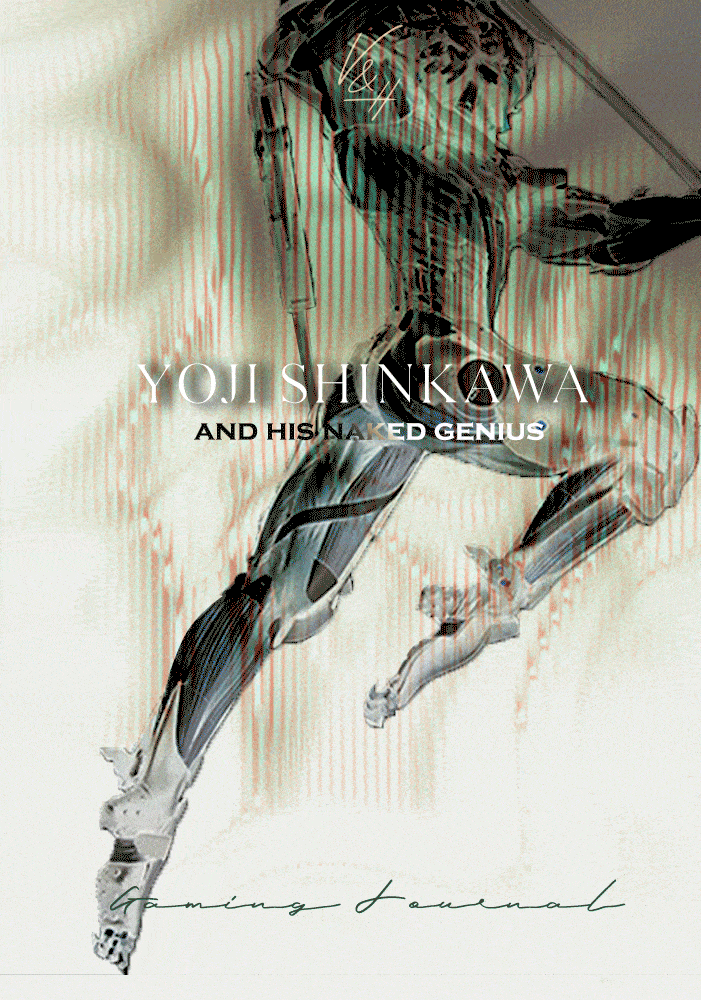
One of my friends asked me by what criteria I choose games. I said there should be a pretty male character. He continued: "Of course, but what else besides a handsome man can you be captivated by the game?" No, my friend, you don't understand. A handsome character is often the only reason I pick up a game. I'm not saying that this is the only thing that defines for me such a complex work as a video game. But it is futile to deny the fact that we are living beings who like beautiful things and especially attractive bodies. Yoji Shinkawa understands this too. As well as the fact that the player spends most of his time looking at the protagonist's back. So why not make that back as attractive as possible?

At around the age of 19, Yoji Shinkawa entered Seika University in Kyoto. It is a private university known for its manga and anime departments, often taught by mangakas. Young Shinkawa's passion for art blossomed as he got acquainted with the books of his compatriots, illustrators Hikozo Ito (1904 - 2004) and Kashō Takabatake (1888 - 1966). Both graphics, the theme of a warrior is present in the works of both. As a technique, Shinkawa first chose gel pens. According to him, the reason he started using his brush pens was because of the influence of Yoshikazu Yasuhiko. In junior high school Shinkawa read a book on how to draw manga and tried using a dip pen, which turned out to be a failed attempt.
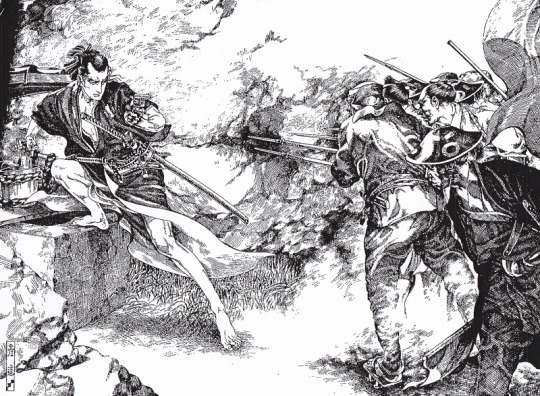
Kakubei Jishi (written by Jiro Osaragi). Illustration for a Shonen Club serialized novel. Hikozo Ito, 1927
His desire can be understood. Drawing with a dip pen allows to create things of incredible sophistication and detail. Just look at drawings of another Shinkawa's inspirator Hikozo Ito. How detailed his works are, how accurately he conveys the mood and characters of the heroes on his works. No wonder they made an impression on Shinkawa. In further practice, he began to use a brush pen, which brought the future designer closer to the technique of his teachers Yoshitaka Amano and already mentioned Yasuhiko, who drew with brushes. Already at a young age, Shinkawa began creating his own illustrations for anime magazines.

After graduating from university in 1994, Shinkawa began working at Konami, one of the leading video game developers and publishers. Here he meets the game designer Hideo Kojima, whose brilliant star has yet to shine on the gaming industry. Maybe it wouldn't shine so brightly if it weren't for Shinkawa. The person who gave birth to a brilliant idea met the person who breathed life into this idea with his brush. One of the first projects that Shinkawa worked on was the game Policenauts, created by Kojima. In this work, one feels that he is still on the way to developing his style - his drawing is similar to anime and manga and lacks any personalized features.
At the same time, in 1995, under the direction of Kojima, Shinkawa began working on his Metal Gear Solid project. Significant changes in Shinkava's style are felt in the work on this project. Almost not a trace remains of the bright anime drawing from Policenauts. The design feels more grim, the characters themselves look more "western" than most Japanese games of the time. As Shinkawa himself noted, Kojima has provided complete creative freedom. The designer only described the intended characters to him in general terms, often indicating only the gender itself. This approach took more time to develop, but at the same time, freed Shinkawa's hands both as an artist and as a designer.
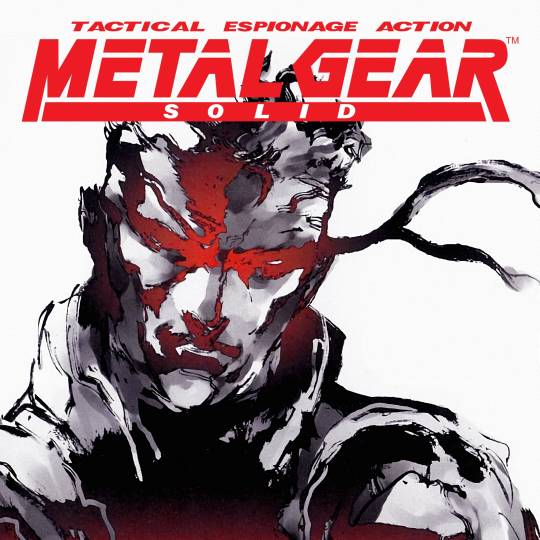
Design, no matter how many beautiful things it creates, is a utilitarian thing. It is not enough to draw 'pretty'. Your work should have practical significance. In the case of video games, character design is about creating an image that is easily remembered in the player's imagination and makes the hero unique. This uniqueness comes from the features of the character itself: his occupation, character, role in the game, relationships with other characters, etc. With space for imagination, Shinkawa tells their story directly on paper, conveying it in poses, clothes, facial expressions and the way their bodies are composed. In the world of Metal Gear, the player is constantly on the battlefield. The main activity of the characters is focused on their confrontation, so they must be in good physical shape. And Shinkawa emphasizes this in every possible way.
The figure of young Solid Snake, the protagonist of Metal Gear Solid, is very stable and tense, but not without flexibility. Shinkawa's line breaks like waves, drawing the relief of the body under the baggy suit. By adding colors on the computer, Shinkawa creates three-dimensional shapes that convey the roundness of muscles. Snake's entire body is covered. But even under the folds of a tight suit, you can see a well-built body.

Notice that Snake's figure is heavily shaded: you cannot see his face. In the first works, Shinkawa did not draw faces and eyes in detail, because the graphics power of the PlayStation did not allow to reproduce the textures in detail. Shinkawa smooths out the facial features, but you can definitely understand Snake's emotion and character.
Much more interesting and artistically opposite to Snake is the figure of Gray Fox. Shinkawa's vision of a character goes beyond just a form designed to perform a certain function. For Shinkawa, the body is another way to tell a character's story, to reveal his essence before the player discovers more information about the character. This is how the means of artistic expression in art work. Looking at a picture, you subconsciously note the things that the creator put into it. You can't always explain exactly what you see, but you always accurately identify the emotion that excites your mind in the very first second of contemplation.
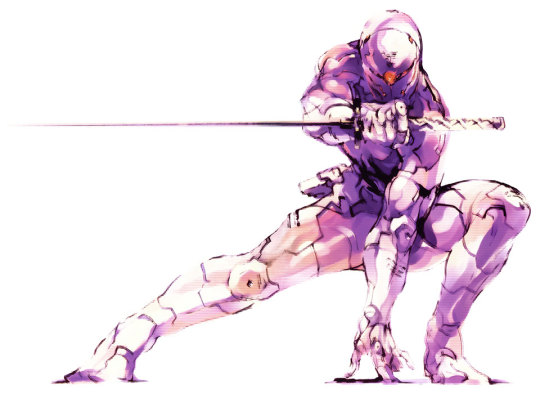
Shinkawa plays with the player's imagination. Gray Fox is a cyborg, but in his image there is not the slightest hint of the artificial nature of his body. It is sculpted by the muscles that transmit the plastic to its exoskeleton. It seems to be pieced together from scraps and feels lighter and more flexible compared to Snake's living body. The designer goes deeper than just trying to convey the image of a ninja literally. He depicts a slender solid silhouette - only a shadow of a mercenary, in which the embedded image of a ninja can be clearly read. A victim of horrific experiments, he hides his mutilated flesh behind a cold cyborg body made in the colors of steel and human flesh. The gaze of the eyes disappears behind the mask with an eerie glint of a red sensor that resembles an eye. Shinkawa does not resort to excessive or even any careful detailing. The designer moves away from unambiguous and finished images. All superfluous and unnecessary details are cut out, leaving the content embodied in a fragile, fleeting form.
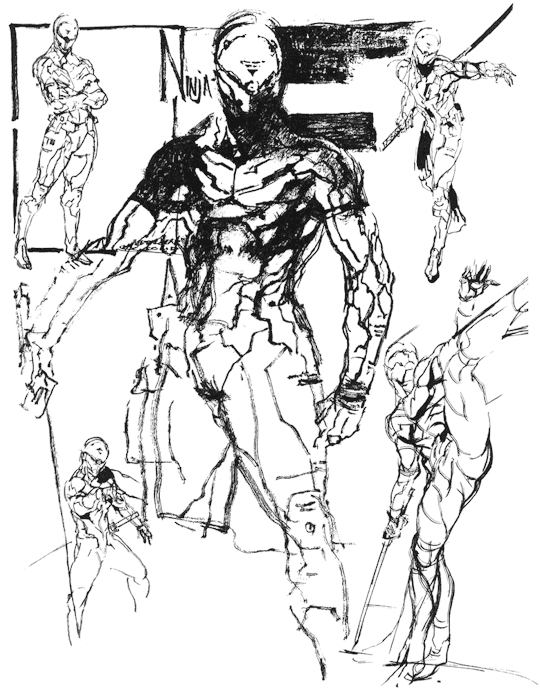
As Shinkawa noted, one of his inspirations is the French artist and author of comics Jean Giraud, better known as Moebius. Giraud is closely related to cinematography. He worked with Ridley Scott on the films Alien (1979) and Blade Runner (1982), created costume design for the cyberpunk film Tron (1982), was involved in the creation of The Fifth Element and many other projects. Although this fact may seem insignificant, it is still quite symbolic in Shinkawa's work. Kojima, with whom the artist created images for games, opened another means of artistic expression for the game industry, including elements of cinematic art in the game, namely cutscenes. Prior to this, narrative was part of the gameplay, presented in the form of long notes or short notes. Cutscenes made it possible to directly connect the gameplay with the story, making the work a single whole.
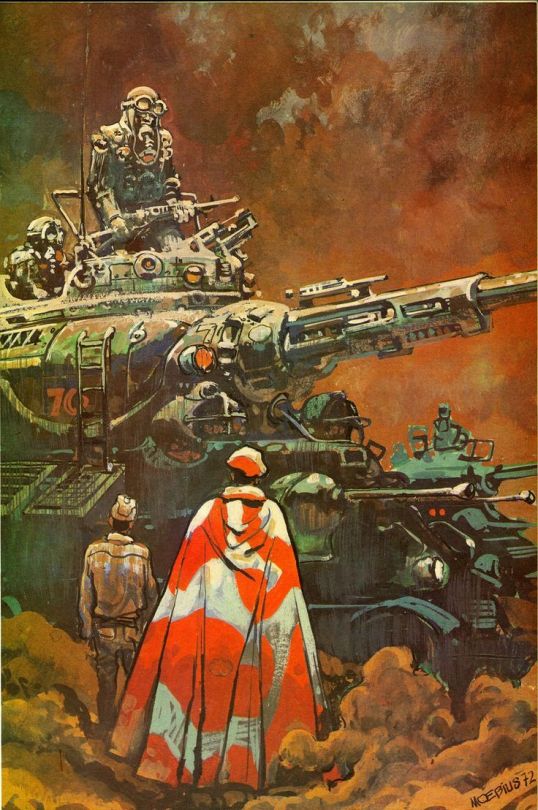
Illustration to Gordon R. Dickson's work Pour quelle guerre. Jean Giraud, 1972.
The large number of cutscenes typical of Kojima's games deliberately create an opportunity to examine the characters from every possible angle, revealing Shinkawa's genius. For the designer, this is a kind of art camera, where his creations are presented in various poses and lit up like curiosities, playing with the player's imagination. When I started playing Metal Gear Rising: Revengeance again recently, this became more apparent than I thought. Alongside cinematic scenes, there are plenty of close-ups with unexpected angles. The characters are not just pleasant to watch. You want to interact with them.
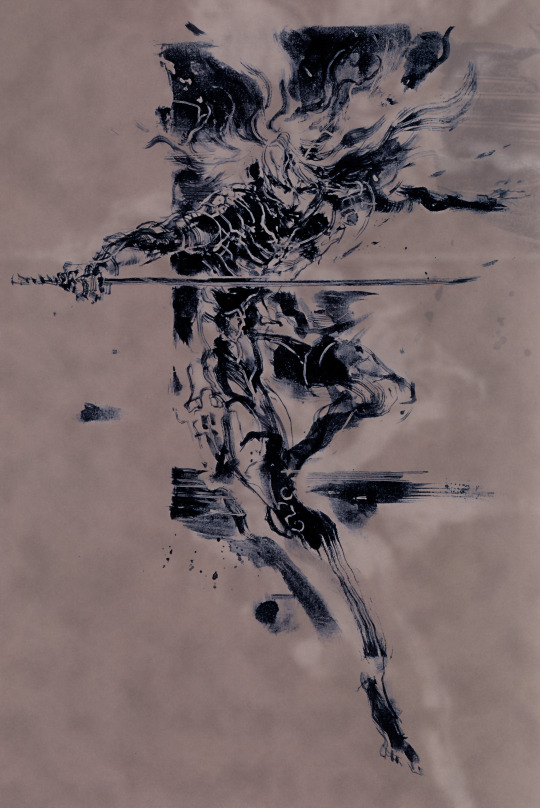
My favorite work of Shinkawa. Stylistically, it is very similar to the works of Yoshitaka Amano: a smooth silhouette that practically melts on the plane of the sheet. The composition is minimalistic, but very meaningful. With one sketch, Shinkawa conveys the character's name (in Japanese mythology, Raiden is the god of lightning), the plasticity of his young body, and the killer's concentrated gaze.
Raiden's design is probably my favorite. He appeared in the franchise with the release of Metal Gear Solid 2: Sons of Liberty in 2001, via a fan letter to Hideo Kojima. Its author complained about the old characters constantly repeating themselves in Metal Gear. In creating the image of Raiden, Shinkawa moved away from the image of a strong, stereotypical male figure, inspired by the popular heroes of the 90s and the American superhero comics from which he took inspiration. The designer resorted to a more Japanese view of male beauty, which was used by the same Kashō Takabatake in his works.
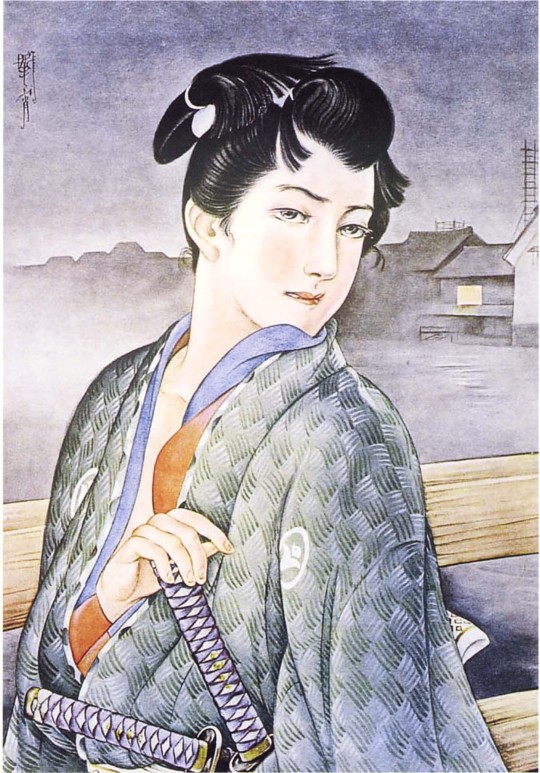
Kashō Takabatake's work on exposition in Takabatake Kasho Taisho Roman Museum. Compare Takabatake's warrior with Hikozo Ito's one. Takabatake created advertisements and illustrated magazines in which the influence of modern is noted. The faces of his soldiers are very gentle and graceful. It was his unique illustrations of beautiful boys (bishōnen) and beautiful girls (bishōjo) that took the world by storm, bringing fame to the artist.
The concept of Bishōnen, or literally from Japanese "beautiful youth (boy)" characterizes not just a man with good looks. In the Japanese view, this is an aesthetic principle that transcends gender and sexual orientation. The roots of this concept stretch back to ancient Chinese literature, the homosocial and homoerotic ideals of the medieval Chinese imperial court, which are found since the Middle Tang Dynasty (~700s). Gradually, this concept penetrated into Japanese and other Asian cultures, and we can observe its examples in the realities of today.
The introduction of such a character did not cause much excitement among fans of the series. Overly refined and too androgynous, Raiden with his silly backstory looked out of place against the muscular Snakes with complicated pasts. However, analyzing Shinkawa's subsequent works for Metal Gear and the gradual change in Raiden's design in particular, it can be assumed that Raiden's image to some extent helped Shinkawa develop more deeply the idea of glorifying physical beauty, born in the image of Gray Fox. On the character concepts for MGS 2, it is noticeable how the designer focuses on anatomy. Raiden's suit fits his body tightly, revealing his supple muscles. Shinkawa leads the line very carefully, it feels taut and elastic, revealing a sculpted form to the viewer. The volume is complemented by the play of light and shadow, which slides along the curves of the figure. To enhance the impression, Shinkawa lengthens the katana, making it more curved to enhance the sense of tension in the composition.
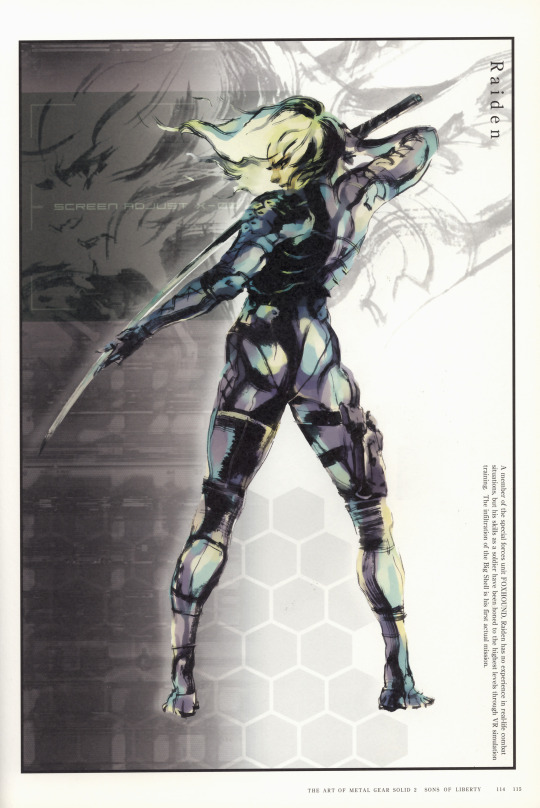
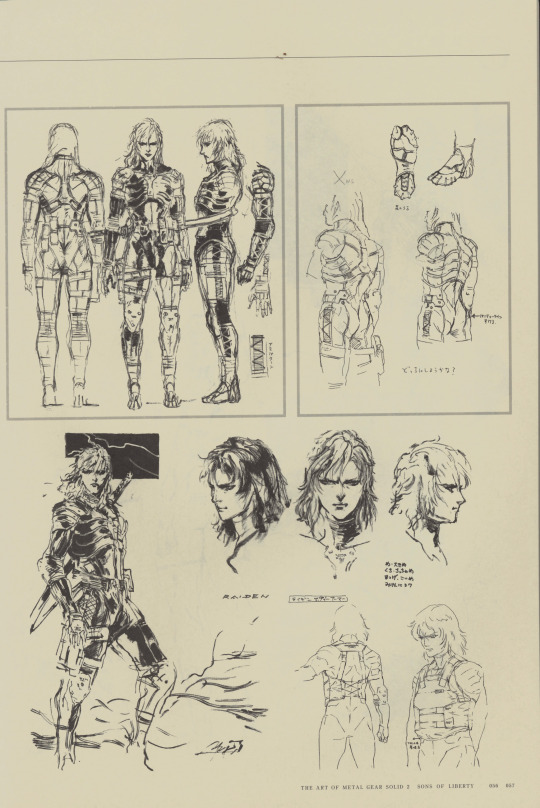
Although we mostly know Raiden today as a cyborg ninja, in the sketches for MGS 2, Shinkawa makes his suit look like samurai armor by adding shoulder and chest plates.
In the work on Metal Gear Rising: Revengeance (2013), Shinkawa continues the chosen path. During this period, the experience and acquisition of one's own style allow the designer to create incredible things according to his artistic solution, twisting the concept of aesthetics to the maximum. The image of Raiden evolves from a fragile young man to a brutal cyborg endowed with superpowers.

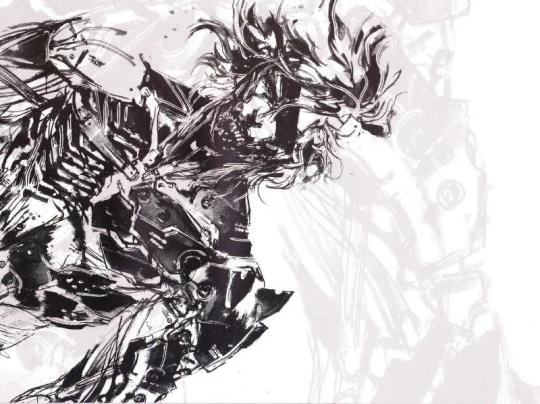
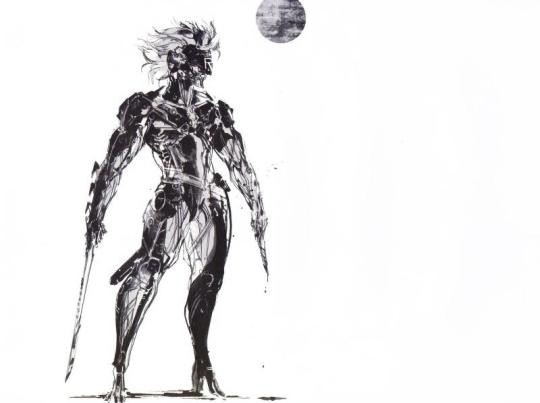
The flexibility of his human body is replaced by the monolithic heaviness of the exoskeleton. Shinkawa abandons the streamlined design used in the image of Gray Fox, which conveyed the ease of movement inherent in a ninja. He appeals to the "pure form", stripping the hero of even his skin as something unnecessary, and turning Raiden into practically a living Écorché (an educational figure showing the muscles of the body without skin). In his desire to get rid of the excess, Shinkawa goes even further. He does not depict a beautiful body, but what makes it beautiful - a skeleton and muscles - the initial form on which everything else is superimposed.
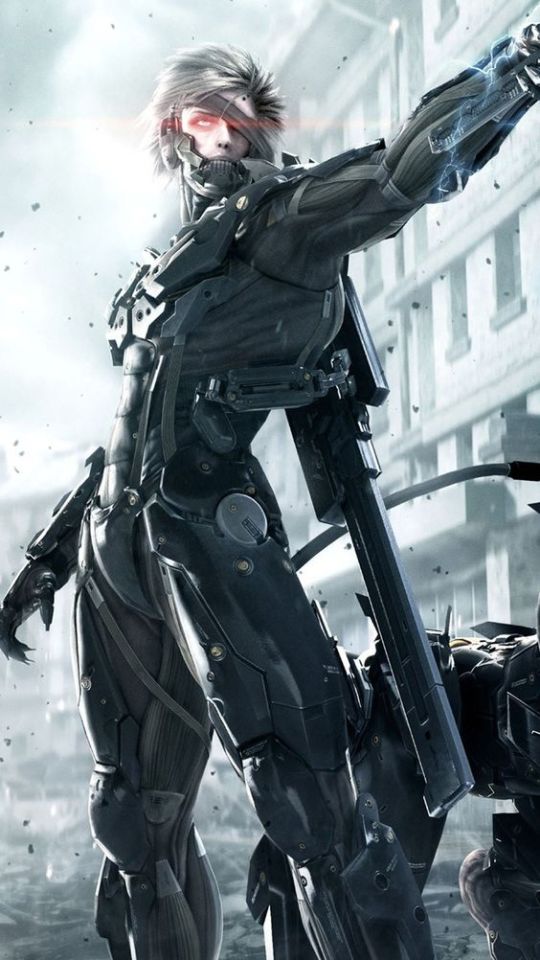
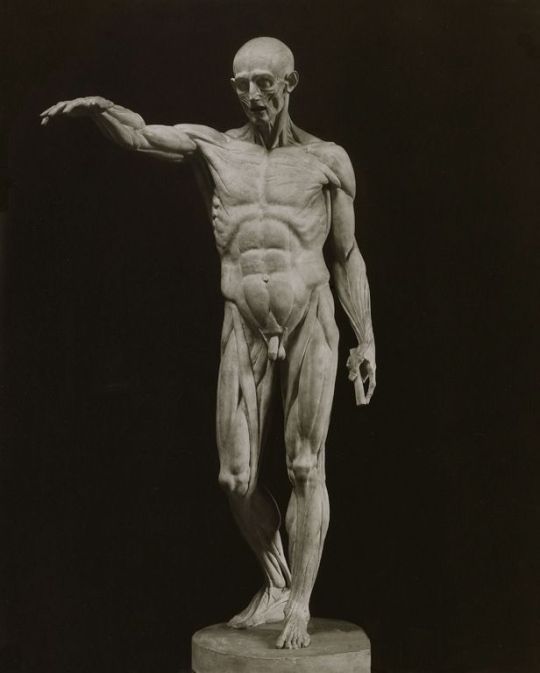
Ecorché. Jean-Antoine Houdon, 1776
Here I should explain what I mean by "pure form". Depicting a simple sketch of a character or creating a complex composition, Shinkawa draws as simply as possible. At the same time, it is important for him to depict not only the design of the character. In the figures of the heroes, attention is drawn not so much to their appearance as to their inner state expressed on their faces. Shinkawa did not specify the details. Characters in rough drawings are perceived as very conventional. Their images are personalized, but conditional.

Eva, Naked Snake, & The Boss. Art to the Metal Gear Solid 3: Snake Eater
Shinkawa avoids unnecessary trifles, preferring empty space. The artist's brush moves almost chaotically, revealing the smallest nuances of the image. With each subsequent game, his technique acquires clear features of traditional Japanese painting. In unfinished, at first glance, ink spills, Japanese artists sought to convey not the appearance of things, but to capture their spirit, to imprint their state or their own impression on the canvas. The artist lays down a minimum of lines and tones sufficient to recognize the form, texture and effects to be felt. Ink spills change in all possible shades of black, the vague outlines of the image make you feel the changeability and fleetingness of the moment.

Screen with pines and bamboo. Tohaku Hasegawa, Nanao Museum of Art, Ishikawa, 17th century
This approach to the image has advantages that could turn into disadvantages for the designer. Since the main point of Japanese painting is not the realistic accuracy of the surrounding world, its reproduction does not require a thorough knowledge of the anatomy or structure of objects. But there is one more thing that I deliberately did not mention before this. Despite the fact that Shinkawa appears as a graphic artist in his design works, he studied oil painting at Seika University. Painting, unlike graphics, is not characterized by vagueness and sketchiness. Shinkawa does not completely get rid of the influence of the acquired equipment. The volume of his figures protrudes beyond the surface of the sheet, creating the illusion of depth. But Sinkawa's best pictorial past can still be felt in his appeal to anatomy as the basis of the physical embodiment of the hero, the transmission of the story behind him. At the same time, Shinkawa's works are almost painterly, with a lot of color strokes, even if he uses only one color. This is a characteristic feature of Japanese painting, the flatness of which the artist transforms to his own needs. Thus, using the ideas of Japanese painting and removing the excess, Shinkawa exposes a pure form. And his experience in oil painting allows him to depict it accurately.

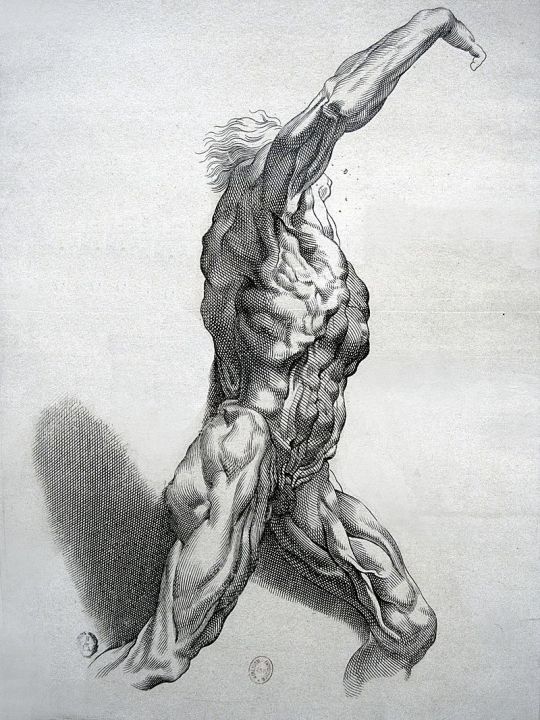
Raiden collectible figure Écorchéchisel. Paulus Pontius,
~1640. Engraving by Rubens
In the concept art for Rising, Shinkawa focused on finding the perfect representation of anatomy that would emphasize the athleticism of the character. From athleticism, in turn, comes sexuality, which Shinkawa instills in robots and cyborgs. Raiden is a killer machine. Even if his blade is an instrument of justice, he himself admits that in order to protect the weak, he kills the strong. His desire for battle, thirst for blood, and pleasure in pain - all find expression in his appearance.

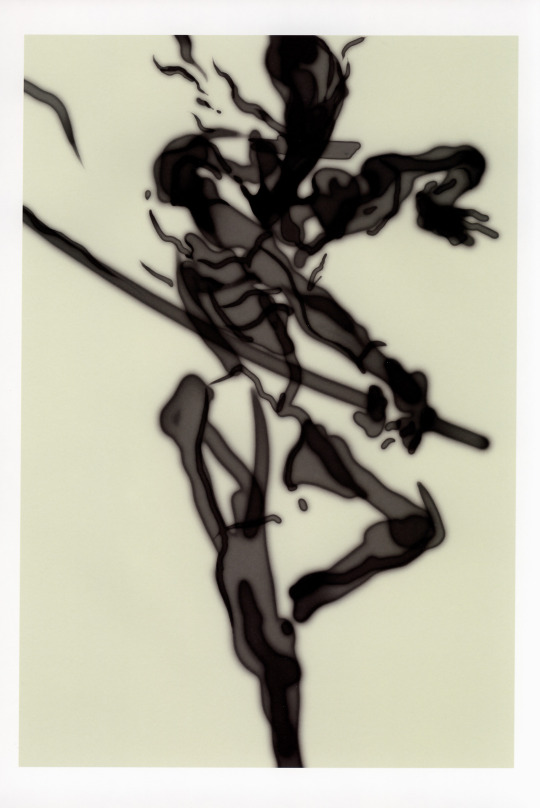
Much more can be said about the work of Yoji Shinkawa. Maybe I would like to do a review on his metal gears themselves, where it's also possible to discover a lot of interesting things. Or about his concepts for Death Stranding and the game itself in general when I finally get through it. In this part, I wanted to share my thoughts on what most touches me in the designer's work.
So yes, it was review on Raiden's butt
Credits:
Metal Gear Solid galleries
The Art of Metal Gear Solid 2: Sons of Liberty
Metal Gear Solid 3: Snake Eater Art
Metal Gear Rising Revengeance Artbook
In the shadow of Kojima: Yoji Shinkawa, designer of Metal Gear Solid and Death Stranding
Gif used for cover image by Erica Anderson
#metal gear#metal gear series#mgs#mgs2#mgs2 sons of liberty#mgs raiden#raiden mgs#mgs2 raiden#mgs3#mgs3 snake eater#metal gear solid 3#mgrr#metal gear rising#metal gear rising revengeance#metal gear raiden#mgs snake#solid snake#metal gear art#yoji shinkawa#shinkawa#japanese art#hideo kojima#kojima#my articles
377 notes
·
View notes
Text
Lego Love on a Weekday
Monday. 23.10.23. I was on a legit high from the UP-Ateneo game last Sunday and honestly, I dragged myself to our HQ. Traffic was considerably light so, that's a plus point. There was a slated team building and as always, I came without expectation. What caught me off guard and pleasantly surprised me was that this team building involved Lego and dominoes. Lego is my childhood toy of choice alongside my BMX bike. Of course, I was on game on mode and got a decent score of 4 out 5. I was in a group where 2 were ex-team mates, 1 current team mate but from a different sub-unit and another team mate from a different department but we considerably closely collaborate. In my four years in my current org, this is probably my favorite team building activity. Yup, it takes quite a while to get my RBF interested, but here we are. The organizers were the same ones last year; so again, this is a pleasant way to jumpstart Monday before my long overdue mega leave, too. It's also something worthwhile since we're in full convergence mode! What I'd like to keep are some mental notes I can go back to a year or so from now in line with my Project Road to 40 and Outta MNL. Tribes are stronger than a lone wolf. Human beings are meant to socialize in order to survive and theoretically evolve. As a lone wolf trying to veer away from my trust issues, this is a WIP may be ad infinitum-ish. LOL. Ayoko mag-commit, so let's leave at that. While winning the game is the obvious end, it's how you play it that matters most. Been a goal-driven bitch with no surrender for over more than two decades, so, I like winning, a lot. I have to come clean that winning is my drug of choice. Well, it still is. But losing does not mean you don't win at times. It's me in my era of choosing my battles. Ready na talaga tayo for mature roles. HAHAHHAHAHAHA. Alam mo 'yung gigil na gigil ako yday sa tallest Lego in 3 minutes tapos, hirit nung second place is: Dapat manalo ako dito dahil nilalaro namin ito ng anak ko. At that time, my heart leaped and while I kept piling the blocks, hindi ko na pinatibay 'yung foundation. OKKKK. FINNEEE. I will give this guy his win. LOLLOLL. Obviously, I am winning at that time and I can easily beat the shit out of him, but sigeeeee. This is me being the bigger person. And yes, Lego gets me... always. Shemay. Entering my dalisay state of mind na ba talaga itoooo? I can imagine mother dragon breathing down my neck again and telling me to keep up with being dalisay kasi dream niya sa akin 'yun.
Teamwork makes the dream work hard and come to life faster. Easier said than done because it takes more than a tribe to build. Back in my start up era, I've learned the painful lessons of not giving a fuck in the name of winning. SIGH. This era allowed me to see that strengths come with weaknesses, especially mine. A team is always dynamic and diverse. This is where I slowly embraced that everyone, including me has a scope and a limit. It's always a buy one, take all kind of thing. While I still am learning the ropes of building a culture in my new team, I can say that teamwork is the secret sauce in any project.
Saying go and no is essential. I remember so well that when I had a 1 on 1 with my junior, I asked for feedback. Initially, he said, everything is going well and that he's is able to enjoy his wellness leaves. I actually prohibited him to work during his breaks because I believe that doing so is counter-productive and a mortal sin, even. Previously, he's been taking leaves to focus on his unfinished tasks. I asked again saying that: Hindi naman puwedeng walang area for improvement. So, please, indulge me. He paused for quite a while and I looked at him straight in the eye as I came closer to him. LOL. He said that he worries about me quite a bit because I seem to be stepping on the gas too much. He wonders why I haven't taken a wellness leave since I moved to our team. Na-dale ako ng junior ko. He said that I should take a break soon. Ergo, eto na nga po ang mega leave natin kaso may dumating na namang paganap. Nanganak na naman po tayo ng collabs. End of sharing. Saka na, 'pag natawid na. I often catch myself resisting the urge to be back to my workaholic era. LOL. It's too tempting, HOWEVER, we won't indulge all the way. Saktong tikim-tikim lang like me right now. :D It's 2:45 AM MNL and I'm off to tick some items off my to-do list. My plausible alibi: I'm on leave starting the 27th and will be back after the long weekend. LOLOLOLLOLLOLLOLL. Fair enough, ain't it? Ain't it?
Your moral compass brings home the bacon and breaks the legs of your opponents. The thing is, moral compass is a rarity these days. I guess that this is one of the most precious lessons that I got from mother dragon and my second dad. Though my sins are scarlet, I try my best to hang on dearly to my core's Polaris. Again, never an easy journey and this mindset brought me down the dumps and 12 feet below the ground at times. But, I'm not budging. As Steve Jobs says: You can't connect the dots looking forward; you can only connect them looking backwards. So you have to trust that the dots will somehow connect in your future. True that. So true. HOWEVER, as you move forward, you ought to bring with you the wisdom, the lesson, the questions. Also, you won't be able to move forward without facing your past traumas, biases and whatnots. EME. Ang aga-aga na naman po; but, just making habol stuff I'd delegate. Speaking of delegation, as a recovering lone wolf and in the name of character arc development, here I am in yet another social experiment. HUHUHUHUHU. Eto na ako sa era ng delegation doused with inception. HAHAHAHAHAHAHAHAHAHA. As an ex-Type 4, nasa integration na yata ako Type 8 and 2. LOLOLLOLL. Hindi siya madali as in. Pero I've learned to be as grounded as I can lalo kapag may very strong resistance. Dati, I usually bulldoze my way to the goal. SHEMAY. Sarap e. Gets the job done right away na, I get to build my skyway pa. However, it's usually a skyway to hell. HAHAHAHAHAHA. I guess, I thrive in neutralizing conflicts talaga pero ngayon, may compassion and lambing na ako, even when ayaw ko talaga na I don't get things my way. Ang aga na naman pong pasavogue ito, pero game na. Let's slay more dragons and put the babies to sleep because, this is another day, shall we?
0 notes
Text
So, I just listened to They Might Be Giant's "Spiraling Shape" for the first time (I know that's hard to believe, since I keep making references to Birdhouse in Your Soul), and... I would be surprised if Junji Ito's famous "Uzumaki" wasn't at least partially inspired by this song.
#they might be giants#Factory showroom#Spiraling Shape#Uzumaki#Yes I know Junji loves the Beatles but#They can't be the only band he listens to#junji ito#I want to kill my phone it keeps autocorrecting Junji as Junior#Can you imagine; Junior Ito#Junji ito Uzumaki
1 note
·
View note
Note
Could you write something about natsume getting a hug?? Just, from whoever n for whatever reason. I keep thinking about how no one ever really hugs him n it makes me sad
x
The absolute last person Joji expected to see today was Natsume Takashi.
Joji slows to a stop on the corner of the street, a block away from the train station, and stares shamelessly.
It's been a decade since the last time he saw Natsume, but he recognizes him immediately. Of course he does. His light hair and eyes aside, Joji has thought about him on-and-off since junior high.
Joji remembers that rainy day when he was thirteen, an empty desk in the middle of his eighth grade classroom, Ito leaning over in his chair to whisper, "Did you hear? Natsume was in the ER. He almost died. The police are looking at his foster parents."
It was as if he'd been plunged into a pool of ice water. He sat there, frozen, while their teacher called them to attention for homeroom and announced that Natsume wouldn't be in their class going forward.
What was the last thing Joji had said to him? "It's no wonder your parents didn't want you." Why the hell had he said that? A book, if he remembers right. He'd lent it to Natsume and Natsume gave it back all water-damaged, like he'd gone for a swim with his backpack on. Natsume's eyes were on his hands, on the ruined book, and he'd tried to apologize, said he'd pay for it, but Joji just snatched it away, ticked off.
"This is what I get for trying to help you, I guess. It's no wonder your parents didn't want you."
Joji is almost twenty-four now. He's going into pediatrics. His fiance, Sakura, is a foster parent. She is currently the proud and fiercely protective mother of two beautiful twin girls.
Sora and Miu are terrified of adults and they go everywhere together and sometimes they make up stories. Sometimes they lie, about why their uniforms are torn, why they're home late, why their lunchboxes are covered in dirt. They have this look in their eyes sometimes like they're just waiting to get hurt again.
Sakura has the patience of a saint. She never raises her voice. She stitches their torn uniforms, replaces their lunchboxes, and, on more than one occasion, has marched into their junior high school and threatened the staff with physical violence if her babies come home with bruises one more time.
Needless to say, Sora and Miu adore her. It took them longer to warm up to Joji, but they're there now; no longer flinching when he moves in their direction, greeting him happily when he comes over for breakfast, smiling shyly when he staggers into the apartment underneath the weight of two giant stuffed rabbits that cost nearly half his paycheck, because it's their birthday, Sakura, they need them.
Joji tries to imagine someone telling them "this is why your parents didn't want you" and goes absolutely breathless with rage.
Natsume glances up from his phone to look right at Joji, as if someone had pointed him out. Caught staring, Joji shuffles in place for a moment, and then squares his shoulders and heads over.
He's expecting the Natsume of his memory; he's expecting him to curl his shoulders and duck his head, the way Joji's girls still sometimes do when a stern auntie wants to talk to them.
He's not expecting Natsume to level him with a clear, politely confused gaze. He pockets his phone, and shoves his hands into the front pockets of the cardigan he's wearing; a size too big, like something he borrowed out of someone else's closet, but it's a charming look on him. He's dressed well, in dark-washed jeans and white high-top sneakers, and his silvery hair is long, probably long enough to fall past his shoulders if he didn't have it piled up in a bun. There's a squat calico cat at his feet, glaring up at Joji with judgmental green eyes.
"Can I help you?" Natsume asks kindly. His voice is a shock to the system; Joji remembers him like it was yesterday.
"Oh," Joji says, stymied. It never occurred to him that Natsume might not recognize him in turn. "Um, I'm Watanabe Joji. We were classmates in eighth grade."
"That's right," Natsume says with gratifying quickness. He looks a little embarrassed now and returns Joji's short bow. "Sorry, it's been a long time."
And we weren't exactly friends, he doesn't say, but that common knowledge sits neatly between them.
"Ten years!" Joji replies with some forced enthusiasm. "Is that why you're here?"
"Sorry?"
"The, ah, reunion this weekend? Ito, from our homeroom back then, put together a whole thing. Our whole class is getting together for dinner and drinks."
It occurs to him that Natsume might not have been invited. Joji thinks that's less because he isn't welcome and more because Ito almost certainly didn't have his contact information. The few times his name has come up, Joji's friends have gone quiet and melancholy. A few of them are parents now, or aunts and uncles at least. All of them know better than they did when they were mean, shitty little teenagers.
Joji opens his mouth to assure Natsume that they'd love to have him, but Natsume cuts him off with a laugh.
It's not a mean laugh. It's not unfriendly in the slightest. But it stings anyway, because Natsume is laughing out of pure disbelief.
"No, no," he says, waving a hand, "god, no. Could you imagine?" he adds, glancing down at the cat. The cat huffs, settling a little more solidly against Natsume's ankle. "We're just passing through, actually."
"We?" Joji asks dumbly. Did he mean himself and the cat?
It's Natsume's turn to get cut-off, this time by a long, drawn-out shout of "Takashiiii!"
A short, russet-haired young man around Joji's age comes barreling down the sidewalk toward them at a flat-out run. Joji's first inclination is one of alarm, but Natsume steps forward with his arms outstretched, and the stranger collides with him in an embrace that looks like it hurts.
Natsume is laughing again, but it's softer this time. It's the warmest sound Joji has ever heard him make.
"What's this for?" Natsume is saying, patting him on the back.
"Just missed you," his friend replies.
"You saw him twenty minutes ago, Satoru," comes the exasperated call from further down the road, and Joji glances over to find a small group headed their way, laden with shopping bags.
"Yeah, exactly," Satoru says, leaning back without letting go, just enough to gaze up at Natsume with a cheeky grin. "I'm all Takashi-deficient. It's pretty serious."
"Sounds serious," Natsume replies, and agreeably keeps an arm wrapped around his shoulders as the rest of their group catches up.
A tall, dark-haired man stoops to pick up Natsume's cat, and it settles agreeably in the crook of his arm. The brown-eyed woman beside him lets out a coo, shifting all her bags to one hand so she has one free to scratch it behind the ears.
"We're being rude," the dark-haired man says in a soft, pleasant tone. "Who's this, Takashi?"
Natsume introduces Joji as an old classmate, giving absolutely none of their history away in tone or expression, but somehow all of his friends seem to clue in to something anyway. Their collective demeanor shifts, in an unidentifiable way, even if their polite smiles don't slip an inch as Takashi introduces each of them in turn.
All but Nishimura Satoru, still tucked up against Natsume's side, who gives Joji a positively poisonous look.
"Okay, Satchan, you're going to lose privileges if you can't be nice," Kitamoto says dryly, and extracts him from Natsume's person with a deftness that speaks of years of practice.
"Nooo," Nishimura says, but it's curbed quickly by Shibata shoving a bag at him and snapping, "Carry this! It's that stupid lucky cat statue you just had to have, and it's heavy!"
"It looks just like sensei! Tooru loves it, too!"
"I do," Taki admits.
It's a warm afternoon, right at the end of August, the sky turning golden with the beginnings of dusk. Joji still manages to feel cold.
He grew up, but Natsume did, too. He always regretted what he did, he always wondered if Natsume was okay, wherever he went, but Natsume hasn't seemed to spare him a second thought. He's got his own friends now; bright, kind people who look like they'd raise hell for him. Who run to meet him.
Joji missed the chance to have a place in Natsume's life. He's a footnote, now, and not a very good one.
"Jojojojo!"
The bright voices have him spinning around, forgetting everything else, and he lights up when he spots Sora and Miu waving at him from the other side of the street. Sakura has a firm hold on their jackets so they can't go spilling out into the street until the pedestrian crossing sign lights up, and then she releases them like a couple of eager hunting dogs.
Natsume's friends shuffle to one side politely, and Joji steps forward to catch his girls when they reach him. They're so beautiful and he missed them so much, this weekend they were away to visit Sakura's parents. He kisses them each on the head, and then kisses Sakura on the head in the name of fairness, and it makes all three of them laugh.
Taki coos just like she did with the cat, hands clasped together under her chin.
"What sweet girls!" she says. "Are they yours, Watanabe?"
"Yes," Joji says proudly, putting one arm around each of their shoulders. They've come so far, not hiding behind him from the group of strangers, even if they press into his sides shyly. "This is Miu, and this is Sora. We're adopting them."
Sakura shifts her weight imperceptibly, a barely-there tell. Waiting, he knows, for the surprise, or outright condemnation. She's dealt with a lot of bullshit for taking these kids in, from family and ex-friends and even total strangers. It rolls right off her, and she usually gives as good as she gets, but she hates when Sora and Miu have to hear it. They don't deserve to hear it.
Joji will have to explain it to her, later, why he brought it up. Why he knew it would be safe to bring it up in front of these strangers.
Sure enough, all their faces soften immediately, a gentle transformation. Natsume crouches, gazing at the twins with an expression that Joji remembers from his childhood. The delicate resilience, the willingness to reach out even if he got hurt.
The look on his face ten years ago when he handed back that ruined book, owning up to his mistake and trying to fix it, buying Joji a replacement even after Joji said something unthinking and cruel.
"I was adopted, too," he says.
"Really?" Sora asks quietly.
"Really," Natsume tells her. "My parents died when I was little. I wasn't an easy child to care for, even though it wasn't my fault, so I got passed around a lot. It took me a long time to find my place, but I found it. Did you find yours?"
"I think so," Sora says, glancing around Joji at her sister.
"Me, too," Miu adds.
Sakura clutches Joji's hand hard enough to bruise. She won't cry here and now, but he already knows it's going to be an ice-cream-for-dinner kind of night.
Natsume looks up to meet Joji's eyes when he says, "That's good. I'm glad to hear it."
It's forgiveness. Joji hears it plain as day. He didn't get a chance to ask for it-- isn't sure he deserves it-- but there it is, freely given. And it's reassurance, too.
When Joji's daughters used to curl their shoulders and duck their heads, it would always tug at the memory of a boy he used to know, who was as kind as he was desperate for kindness.
Now, he thinks, when his girls are making a mess of the kitchen trying to follow a pancake recipe with their friends, or dragging a stray cat inside with big, hopeful eyes, it'll remind him of this afternoon. Natsume's clear, bright eyes, and the protective cluster of friends surrounding him.
The world wasn't fair to him; it left a mountain in his life that he had to climb, complete with all its pitfalls and crumbling paths and bad weather.
And here he is on the other side, goodness intact. Smiling. Loved.
He found his place. Sora and Miu found theirs.
And god, if that doesn't give Joji hope for everyone else.
"It was nice to see you," he says thickly, hoping Natsume hears his honesty. "Don't come to the reunion, that was-- a stupid thing to say, but-- would you-- dinner?"
Natsume hears it. He tilts his head, considering, and then says, "We missed our train, anyway."
"And I'm starving," Tanuma says agreeably. Clearly, he says it more to agree with Natsume than anything.
Nishimura is the hardest sell, watching Joji with hard eyes. But then his gaze dips to Sora and Miu, and all his sharp edges go soft, like butter melting in the sun. After a handful of tense seconds, he visibly gives up on his anger with a huff. His friends, watching patiently, all give absurd little cheers when it's clear he's on board.
"Fine, but if you live farther than three feet away, we're getting an Uber," Shibata threatens, rustling the shopping bags in his hands with annoyed fervor.
They drift in the direction of Joji's home, and Kitamoto talks Shibata down from the Uber with the promise of ducking into a 7-Eleven for ice creams instead, and Taki and Sakura are fast friends, rolling their sleeves up to compare tattoos-- Taki's is a strange, occult-looking circle that Joji makes a mental note to ask about-- and Tanuma lets Sora carry the fat cat, while Miu pets it with reverent fingers.
Natsume walks beside Joji, calm and unhurried, with Nishimura on his other side. He grew up with so much grace.
"Can I add you to the class groupchat?" he asks without thinking.
"Good luck with that," Nishimura butts in, not unkindly. "He's the most unreliable texter you've ever met. He left me on read for like two days once, and we live together."
"You'd have better luck with an email," Natsume says apologetically.
It's more than Joji thought he'd get; they exchange contact information, in the middle of this chaotic, noisy group making its way down the street toward the well-lit combini on the corner and then, beyond that, home.
Natsume doesn't seem to have any interest in reconnecting with his old classmates, and Joji doesn't blame him for that. Even though it will certainly piss Ito off to be kept in the dark, even just for a few days, Joji decides it's for the best.
Nishimura's goodwill can't be stretched that far.
#natsume yuujinchou#natsuyuu#natsume takashi#nishimura satoru#tanuma kaname#shibata katsumi#my writing#prompt#natsuyuu fic#cha-lii#wanna find a home (wanna share it with you)
159 notes
·
View notes
Text
Esme stuff :)
@tragiclyhip, @youflickedtooharddamnit, @secretaryunpaid
I'm at my sister's helping with the cats and I send this to my husband with the words: It's a PURR-ITO!
There's a long pause. And then he sends back:
"I'm ready for that divorce now."
Rude.

Well that's one (two, considering he is a twin) we definitely don't need a paternity test for.
Senior and Junior. Looking just a little alike lol.

When you’re getting (re)married on a beach, normal shoes just won’t do! Look at these beauties:

Our sweeties Brookie and Takota. Having one set of twins had been a (pleasant) surprise and quite the adventure, so you can imagine when we got the news that these two were on their way!

Brookie now:

Takota:

Me: (practically hyperventilating) “I dunno if...”
Her: “Don’t worry! Daddy lets me do this all the time!”
That doesn’t make this any better, kiddo. lol.

Kota relishing his role as a big brother! Ever since we told the kids they were going to have a sibling, he’s been nothing short of ecstatic at the reality of no longer being the baby of the family.

Yeah, you’re cute. I guess.
#gawdIloveyou

What? You don’t do your Easter egg hunting on the beach?
#lifeattheRakeRanch
#lifeisgoodinAustralia

The one that made me a mum. For so long, I’d wanted this. I longed to have a baby; that excitement that comes with the news of expecting, watching as your body changes throughout the months, the feeling of them moving inside of you. I wanted all of that. And when I lost a baby with he who shall not be named and then my marriage fell apart, I’d thought my chance was gone. I was a mess; truly believing I’d never...EVER...let someone get that close again. I thought I would never trust someone enough to even fall in love with them, let alone give everything of myself to them. I’d done it once and it had been a disaster and I didn’t want to go through that again.
And then I met Tyler. Who then proceeded to not only woo me with those beautiful blue eyes and that sexy voice and crazy ass body, but totally seduce me as well ;)
Millie was the result. Well, the initial result, anyway. Proving that some good came out of Dhaka after all :)
She was...and still remains...everything I ever wanted.

He’s mine now, lady. ALL MINE.

Our bedroom at the lake house. Turned out even better than we expected it too! And look at that bed. I love a large playground ;)

Of course, no place of ours is complete without a hanging bed. So at the lake is no exception. A little project the husband is working on. A nice addition to the patio outside our room.

I can’t resist. This place is just incredible. I know I argued against buying it because we really didn’t need another home to worry about and try to find time to visit, but it is the perfect getaway. It’s beautiful and peaceful here. And so different from home! We’re so used to sand and surf and sun. This is a nice change every now and then. And my husband lets his beard grow out and wears plaid. So yay! Lumberjack! lol

Marry your best friend. The one that can make you laugh even when all you want to do is cry. Marry your protector. The one who will stop at nothing to keep you safe. Marry your truest confidant. The one who will keep all of your secrets. Marry the one you know would make an amazing parent to your children. Marry the one you both love and lust for. And always will. The one who is the best hug and kiss you’ve EVER had. Marry the one that picks you up, not kicks you when you’re down. Who you can’t imagine your life without. Who makes you forget everyone and everything that came before them.
Marry THAT one.
Trust me.

12 notes
·
View notes
Text
[INTERVIEW] An Interview With AleXa: Why This AI “Villain” Is Actually A Down-To-Earth Sweetheart

What The Kpop recently had the opportunity to sit down with K-pop idol AleXa for an interview. Due to COVID-19 restrictions, we held the interview via Zoom. However, even across the internet, AleXa’s warm personality shined through, charming our staff with her down-to-earth way of speaking and thoughtful answers.
The popular solo artist will soon be releasing a new track entitled “Rule The World” on September 4th. The song is a collaboration with gaming music star TheFatRat. In addition, she has confirmed her comeback for October, making fans excited for the news that her title track will be produced by famous hitmakers LDN Noise.
Before her new releases, however, get to know more about this talented artist by reading our interview below! From her tastes in anime to which female role models helped form her into such a strong woman today, read below for questions that she’s never been asked before.
WTK: Hi, AleXa! My name is Amy, and I’m from What The Kpop. First of all, I just thank you for meeting with us today. I know that you’ve got a busy schedule, so I’m glad that you were able to take a few minutes to speak with us.
AleXa: Oh, you’re very welcome.
WTK: Before you were actually a K-pop idol yourself, you did so many different things! You’ve done cosplay in the past, you’ve done voice acting, you’ve been on shows where you tried out for different things, you’ve taken part in long training, etc… all leading up to this point in your career. So, first of all, just to get things started, can I ask you what’s been your favorite part of the journey so far?
AleXa: Let’s see. I mean, from way back until now, I think the thing that I liked the most about my journey is not just one thing. Since it’s still ongoing, it’s just the fact that I get to see myself improve, that’s the thing. So, improvement for me is probably the thing that I really enjoy about this process.
WTK: Since your debut, you have had quite an unusual concept. For those that don’t know, it’s about a multiverse and you’ve had a trilogy of songs: “Bomb,” “Do or Die,” and “Villain.” You’re avatar or AI escapes into a physical body and then goes into the real world, right? We know this suits you really well since you’re a fan of dark concepts and horror and science fiction. So, if this were to ever happen to you in real life and you became an AI, whose body would you want to take over?
AleXa: Dwayne the Rock Johnson! (laughs) Because I just want to be the Rock! I mean, who doesn’t want to be the Rock? (laughs again) So, definitely Dwayne the Rock Johnson! Yeah!
WTK: When we watched the making video for your recent “Villain” MV, we saw you doing the Naruto run and already knew that you’re into anime. I know your schedule probably doesn’t allow you too much time anymore, but are there any animes that you’re into recently? Or are there ones that you’d like to recommend for your fans to watch?
AleXa: I haven’t watched anything recently. The most recent thing I watched was the anime adaptation of some of Junji Ito’s work. If you didn’t know, his collections were turned into an anime. If you like horror, I recommend that. But one of my all-time, go-to shows is always “Death Note” or “Full Metal Alchemist.” So, those are ones I wouldn’t mind re-watching again if I find time.
WTK: Your fans, or AI troopers as they’re called, refer to your music as a cultural reset when it comes to how you’ve changed the game. For you, which artist or even what genre was the cultural reset in your own life?
AleXa: I feel like without a doubt I do have to say K-pop was the cultural reset for me. Had I not stumbled into K-pop, I wouldn’t be doing what I am now. Then there was someone also like SHINee. They’ve been a pivotal group, a pivotal senior for me in my career. So, they were my cultural reset.
WTK: Apart from SHINee, I know that you also got into K-pop after hearing artists like Super Junior. Going from a K-pop fan to a K-pop idol yourself, what has the experience been like? Is is still kind of surreal for you or how would you describe the experience?
AleXa: Oh man, it’s definitely surreal! I never thought that in my wildest dreams I would find myself being an idol for my career. Being able to stand on the same stage in music shows as so many wonderful and talented seniors… like it’s incredible. It’s definitely been very surreal for me thus far.
WTK: Recently, you held your own virtual concert, and you also opened the show for IN2IT in India. How did the two experiences differ as far as opening for one group versus having your own concert? Did it affect you that your first solo concert was a virtual concert? If so, what were some of those challenges like?
AleXa: I mean, it definitely is very different having my own concert versus opening up for a senior group. I will say that being able to open up for their concert two times was a really good experience because I learned crowd management. Also, I learned how to feed off of people’s energy for the concert performance. Then when it comes to my own solo concert, even though it was digital, I could still feel everyone’s love and support through the comments because there was a live monitor where I could read all the comments in real time. So, even though there weren’t people there in person, I still felt the presence of them. I’m an extrovert and I’m someone that draws energy from other people. So, virtual concert or online concert, it’s just both a really fun experience for me.
WTK: So many people did tune into your concert, and I know that a lot of people were leaving comments also, so it was a great success! Do you feel like from here on out that online concerts are going to be more of a staple in K-pop, even once things like COVID-19 slows down and things are as back to normal as possible? Are virtual concerts here to stay?
AleXa: However fast the pandemic does come to an end, I do feel like online concerts, online fan meetings, and everything else that’s been happening in the industry during this time is something that is here to stay. Because you never know what could happen in the future. So, I believe everybody learning the ways of online concerts, the data, the statistics, the reactions, how fans work.. I think it’s something we’re going to wind up keeping in the future.
WTK: You exude this natural charm, charisma and confidence. So, what would you say to younger fans, especially those who are coming up and trying to find their own persona and sense of self confidence? How did you become who you are today and grow into this confident young woman that we know as the singer AleXa?
AleXa: Thank you for that. Let’s see. I don’t know. I would just say, don’t get lost in the crowd I guess. People will always find ways to try to belittle you for ways that you’re different, for ways that you stick out. But embrace those and make those your strong points. Don’t let anybody try to define you as a person. You alone can define yourself. So yeah, take comfort and joy and pride in your individuality.
WTK: Now, I don’t know if you’re familiar much with the Reddit sub-threads for K-pop, but ever since the music video for “Villain” dropped, your fans have been busy analyzing the trilogy and making all these theories about the Alexa universe. I don’t know if you’ve read any of these online, but there is a really popular thread on Reddit and also one on Twitter about the Alexa universe. The summary is that they believe there are different versions of AleXa and that she embodies the different human emotions that each AI version has discovered. What do you say to all of that? Can you give us any hints or have you been able to read any of these fan theories yourself?
AleXa: I mean, I’ve dabbled a bit here and there on Twitter. I’ve been looking at a lot of tweets, and I read the comments. There’s some interesting theories. I mean, when we go into these comebacks and pre-releases and stuff, we know the plot. We know what we’re trying to get into. But then whenever I’m with my staff, we read things in the comments. We’re like, “Oh, well, that���s an interesting take on why we thought of that.” But it’s really cool to see how how imaginative and smart and observant everyone is. Because they catch and piece things together. And I’m like, yes! Those are my smart, beautiful fans! Yes!
WTK: Coming from your label, which is a video production company, have there ever been things that your fans noticed about the videos that maybe you didn’t even notice yourself at the time?
AleXa: Oh, I’m pretty sure I’ve seen some comments noting some things and seeing the background or like they’ll think a certain layer goes with a certain thing. I will say though, this is not something we intended for, but with the release of “Villain”— of course, we do have a small, kind of floating, pyramid-looking thing at the end, and I do this [thing] with my hands. But it’s kind of funny because some people thought we were alluding to the fact that we are a part of the Illuminati! But we are not. (laughs)
WTK: Yes, just to make that clarification! (laughs) So your music, like we said, features the image of this strong, independent woman where you are like cyborg, pop, diva (and we love it, by the way). When you were growing up, did you have many strong female role models? Who inspired you?
AleXa: If we’re talking about strong females, then of course, one pivotal character has been my mother. She is honestly one of the strongest women I know. If we’re talking in an artistry sense, since my parents raised me on older music, then people like Cyndi Lauper, Joan Jett, and Whitney Houston. Into the more modern age and as I was starting to grow up a bit, then Rhianna, Brittany, Christina. This is the kind of aura of artists and people that I really looked up to and enjoyed their work.
WTK: If you were ever able to branch out— maybe not on your main comebacks but for special songs or covers— are the genres of music from the artists you just mentioned something you would like to dabble in? Or is there any other type of music that you would like to try for something different?
AleXa: I mean any opportunity I would be given to branch out and just try something that I’ve never done before, I want to try of course. I would love to take the bull by the horns and just go at it! So, whatever and whenever those opportunities arise, yes definitely.
WTK: We know that you have like a “sad boi” playlist when you’re feeling down. When you’re feeling happy or pumped up, however, what do you like to listen to?
AleXa: If I’m having a good mood and I’m just going for a walk or something, I listen to lot of Queen, Fleetwood Mac, some Dolly Parton. Believe it or not, Dolly Parton is the only country artist I will make an excuse to listen to.
WTK: Well, she’s one of the ultimate divas herself so…
AleXa: She really is, she really is! But I don’t know… just kind of like older pop I guess, without all this like synth and heavy bass we have now. Just old style pop music, I guess, is kind of my music sphere.
WTK: I know also that you were a musical major in college, and I am a huge fan of musicals myself. So, I have to know something! Musicals are so popular in Korea, and it’s a big scene there. So, if you ever got the chance and you could work in a musical there, is there a specific musical that you would want to be cast in?
AleXa: A lot! But if I could be cast in any musical I wanted, I think it’d be fun to try Maureen from Rent or Veronica in Heathers. I feel like these both are fun roles [and I’d like] to give it a go.
WTK: One more question! Fans really enjoyed hearing the lyrics you wrote for your last song and are looking forward to hearing more of your work in the future. We know all songwriters have lyrics written in journals, so if you have any saved, do you mind sharing a previously unreleased lyrics with our readers? Just something that you haven’t yet shared with the world?
AleXa: Sure! I mean, I am one of those people that has journals upon journals upon journals of song lyrics. I keep them in my phone as well too actually. If I were to share something real quick, right off the bat, what would it be? What would it be? What would it be? (laughs while looking through phone) See! There’s a lot in here. Yes, yes, yes. Doot, doot, doot, doot. (laughs again) Oh, I don’t know. These are all just kind of… deep. Let’s see. Ok, I’m just going to read these two lines. It’s just something I wrote once. ‘Do I have to rearrange the stars and have them spell our names in the sky?’ That’s it. (smiles)
WTK: Thank you, AleXa! We look forward to hearing how you will use that in a song one day, and we look forward to hearing more from you in both your music and your lyrics too! Before we go, do you have any last words to people that might be reading about you for the first time, as well as to fans that have been with you since the beginning of the journey?
AleXa: Sure! Whether you’ve been with me for a day, an hour, or five minutes, or five years, thank you so much for staying by my side throughout this wild roller coaster journey that has been my career thus far! And I promise to keep working super hard to become a better artist and a better person that you can enjoy in the future. Thank you so much. I love you!
© WhatTheKpop
6 notes
·
View notes
Photo
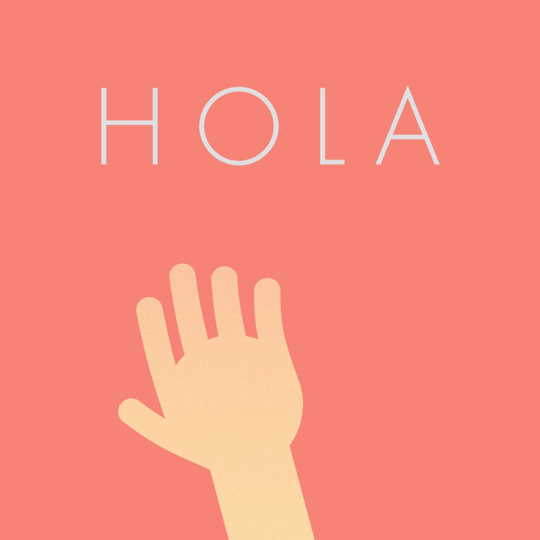
Greetings for surpassing your junior years!
Wherein you discovered lesser rest yet
Yet full or jeers
Now get ready to present your very best
Trust me to choose Humanities and Social Sciences
For you will overcome not just a paper, but even a life test
In here, creative writing can move you into different ambiances
This is also where counseling and social work collaborate
As well as Philosophy let you learn in few glances
If you’re also fond of participating in a debate,
Have fun in speaking and thinking critically
So take HUMSS now, mate!
WELCOME DEAR!
It’s my pleasure to be with you here in my so-called “hood”. So maybe you’ll gonna ask if what is this for. Actually, I was just busy jotting down my ideas until I realized that I have to quit wasting time since this is for a scheduled task. (Hahaha!)
Anyway, let me introduce myself first.
My name is Camille and I’m 17. I’m in grade 12 right now and taking Humanities and Social Sciences strand under the academic track. Be joyful kid, because I’ll be your “not-so-pretty-but-just-tall” advocate for this time!! But before anything else, I want you to be informed about this blog.
This isn’t about your favorite love quotes
This isn’t a site for online dating so stop browsing on my account!
We’ll gonna learn how to become a good student here. (Believe me)
This is a serious business so I’ll be letting you to grab your daily dosage of happy pill right now. Hurry!
Now count 1 to 10 and we’ll gonna start!

So, what is it?
Under the academic track there are four main strands, namely Science, Technology, Engineering and Mathematics (STEM), Accountancy and Business Management (ABM), Humanities and Social Sciences (HUMSS) and General Acadmic Strand (GAS).
If you’re one of a kind having a deep passion towards literary, communication skills, psychology, counseling and law, well, welcome to the club! You’re maybe one of us–having creative minds, passionate souls and soft cinnamon hearts (the last word isn’t a joke!) because those things belong to HUMSS. Dealing with the subjects and lessons within this strand wasn’t difficult, neither easy too. All you have to possess are the following, in order for you to survive:
Two cups of patience (one for yourself and the other for your teachers (oops)
An abundant supply of papers and pens (those are tools for survival!)
ENOUGH self-esteem
A very courageous heart with a deep breath and an immortal soul
LOVE (since it conquers all. even your seatmate)
On the other hand, it is so enjoyable to study HUMSS since it really discuss about humans, society, politics and everything in it. Hey I’ll be sharing you some of my stories about being a HUMSS student for you to find out why did I choose HUMSS and why must you should do the same thing.

“Simula ng Huli” the making
I have the best pals
The first one was the called “best”
Next was only “pal”
In our Contemporary and E-Tech subjects, we had been given a task by our teachers to create our 10-minute short film. We decided to create something different since our fellow classmates agreed to come up with horror films. We made a drama out of a spoken poetry. We do not have dialogues instead we act the scenes that the poem portray.

Share some?
The story began when a Senior High School girl, Marisol, decided to step outside her shell. From an introvert, she made friends with some other people. Now, just like the usual scenarios, they made memories and shared struggles as well. But the sad thing happened then when many of her friends chose to part ways and everything about there friendship ruined. The story ended not in a blissful one, thus, remained melancholic.
The Sample Script
Pero siguro kailangan ko na nga talagang maniwala Maniwala na nasasaktan na ako at kailangan ko nang sumuko Dahil mahirap nang maibalik yung mga parte ng pinunit na pahina nitong bawat kabanata ng ating istorya Mahirap nang manatili sa isang sulok habang naaalala kung pano lang kayo nagparanas ng ligaya pero nagpalit din ng sugat na kailanman ay di na nga mabubura Pero Salamat parin, Salamat sa pagbibigay ng aral sakin na hindi lahat ng nagdudulot ng kasiyahan ay mananatili kailanman Siguro ito na nga ang panahon para matanggap kong ito na..
Ang Simula ng Huli
NOW, LET”S ESCAPE FROM REALITY!
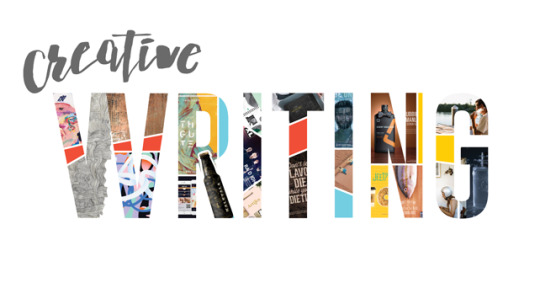
Let us now talk about creative writing
What comes in your mind when hearing it?
Did you know that it is more of thinking?
Writing your thoughts might have spirit!
All you have to do is to hold a pen and sit
So you people with imaginations as high as a mountain’s peak,
Here is where you really fit
In the real world, let us come out and sneak!
It isn’t just about writing guys. It’s actually more on about thinking creatively and separating yourself from this world. And if you will gonna ask if what can I use to describe Creative Writing subject, I’ll just answer you with one word and would expound it..
AMAZEMENT!
Now, ponder of what does being amazed means and you will be able to understand what message you’re intended to receive right now. Just kidding.
Creative writing subject is a break from the real routine of this world. Maybe in a newspaper, it is the feature page. It is the desert in a heavy main course. It is the apple of a pie and can be the water break of your practice. But it doesn’t mean that you’ll have to forget about your self and the society where you belong. No. Creative writing only wants us to breathe and pause amidst the fast run of a train. It wants us to have a short break while watching a long and annoying TV program. To sum it all, it intends to let us escape for a while in this real world through our own imaginations wherein we’re able to create our own world.
To share some, the most unforgettable moment during our creative writing subject was when we’re asked by our teacher to write our own ending of a particular story. Moreover, we wrote also our own short story inspired by a song. But it did not end there, because we usually ought to make a role play out of those stories. Amazing. Aside of those, writing or composing poems with different rhyme scheme is one of my favorite activities too.
To learn isn’t just the goal of this subject, but rather, to make our experiences alive.
”Experience is the best teacher” as the cliche goes, because in my own perception it really gave us the grades. (HAHAHA!) I mean, our experiences and the emotions within those always lead us to a better piece of a story or stunning lines of a poem. This is the reason why many loves this subject. (including our teacher, yay!)
Oh, speaking of experiences, let me share you my great travel ever!
Three Days In the Paradise!
If you are lonely,
Keep in mind that you are best
And made splendidly!
Last June, I and the worship team members of our church had gone to a vacation. From San Jose del Monte Bulacan, it took us 4 hours and 20 minutes to arrive at Bongabon, Nueva Ecija. We spent our first day in Simple Life Resort.
The pool’s water wasn’t very strong with chemical contents since it came from the mountain brook. The staffs were very cheerful, the entrance fee was only 20php while the cottage rent costs 100php to 1000php and that made us stayed there until 7 in the evening.

Simple Life Resort


The “Batanes of The East” and the Lighthouse in Aurora

After an enjoyable swimming and bonding, we headed our way to Dingalan Aurora. The travel time was only 1 hour and 5 minutes. That was the place where we’re really going to stay until the third day of our vacation. The people welcomed us in a certain beach resort and they were very friendly. There, we had rented two cottages.
The sea was so tidy and the waves were very calm that’s why we almost lived there. Incidentally also, we’re fortunate to witness the opening of the town feast happened. The boats made up of flamboyant colors with patrons and bands paraded on the sea.
I and my fellow youths together with our youth leader also did not let the day passed without even visiting the famous white beach resort in Dingalan. We did not actually went there for swimming, but for mountain climbing. It took us about 25 minutes riding a boat from the island where we’re staying in to the white beach resort, and so we’re welcomed by an abundance of jellyfish. It took us almost 30 minutes climbing the two famous mountains in Aurora. But even though my heart almost fell on my soles, the mountain view did not disappoint me. It actually made my breathe away! Believe me, my tears fell when I saw how beautiful and wonderful the scene was when we reached the peak of the second mountain (which was my favorite also), the so-called “Batanes of the East”. The temperature wasn’t that high that time that’s why we really enjoyed our climb. The mountain was still full of green tall trees and the ocean behind us was said to be a part of the Pacific ocean. I almost cry aloud when I thought how Great God is. The aesthetic made me realize that if God alone shaped these majestic things, how special we are, since we were the most important in all His creations.
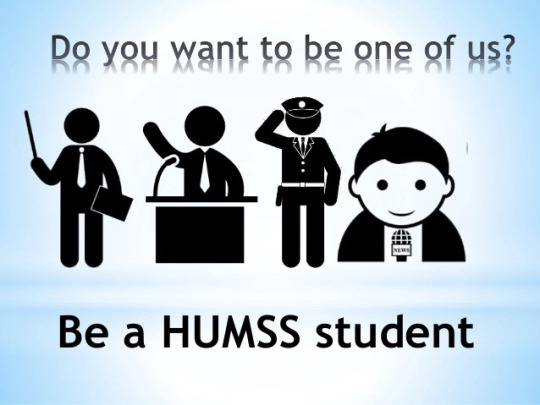
Humanities and Social Sciences is perfect for your run,
It isn’t as harsh as a bullet of a gun
But just as bright as the splendid sun
Now trust me because for sure, you’ll really have fun!
Hey! I hope that I inspired you and encourage you as well as you read through. If you’re still confused about the strand that you’ll be taking for your Senior Years, keep in mind that you have always to follow your passion.
In HUMSS, maybe you’re not going to study numbers, but you will know the importance of those. You’re not going to balance an equation, but you will learn how to find equality and justice despite of the world’s realities. You’re not going to compute for a product’s value, but you will know how to value one’s life and the society’s products. So if you want to become a future world changer, having a passion for humanities and looking forward to a better society, be one of us! Choose HUMSS.
1 note
·
View note
Note
✿ ϡ ✄ ✎ for Nagito and Kokichi
✿ for a happy memory.
A happy memory for Nagito...it’s hard for him to really put one down, because a lot of his happy memories are tainted by the despair/bad luck that brought them. However, one that sticks in his mind as completely, totally happy is the day Chiaki brought her games to class and they all played together. Well...all of those days. When they went to festivals as a class, when they went to the beach, when they celebrated holidays...honestly, those six months he was in 77-B before his suspension were the happiest time of his entire life before or since.
As for Kokichi, he can pinpoint the exact moment when it finally sank in that the institution he was at -- the one he’s at currently -- was a real home, and the people there loved him and wouldn’t betray him. And he’d never admit it because he has a reputation, but that’s one of the happiest moments of his life.
Send ϡ for a sleep headcanon.
Nagito? Sleep? Hahahahahaha. He’s a very light sleeper as a general rule, very easily woken up if he’s even asleep, and he doesn’t like the idea of sleeping aids. He doesn’t want to sleep any heavier than he does -- he doesn’t want to be unable to wake up if something goes wrong in the night. So...he really doesn’t get much sleep at all.
Kokichi not only sleeps like a rock, he is the most horrible bedmate to have, ever, hands down, bar none. He flops around like a starfish and hogs all the blankets, and he will take up most of the bed and smack you in the face and not wake up if you shout at him or smack him with a pillow.
Send ✄ for a favourite movie of my muse’s.
Nagito likes mysteries, but he really likes horror movies best. The more unrealistic the better, honestly! He loves the Chakushin Ari series, Noroi, and any of the live action movies Junji Ito has done (Uzumaki, Kakashi, Tomie). But also he has a bit of a quiet love for Ghibli films, because they’re basically the movie equivalent of a hug. Sometimes you need that.
As for Kokichi, he unironically loves that really shitty Batman movie, not gonna lie. All Batman movies except the dark and gritty newer ones, really. The wackier they are the better. He also does love that US movie Megamind, and as for actual Japanese movies? Anything sentai.
Send ✎ for a school headcanon
Nagito is very smart, and was always in the top ten of his class in middle and junior high. However, once he hit junior high, he never had any friends, and mostly kept to himself. He never joined any clubs, either, and no one ever really invited him to join any. The teachers also never really reached out to him, either, and -- though it’s hard to imagine -- before he went to Hope’s Peak, he was always the quietest, most unobtrusive, most easily forgettable kid in the class.
(If he ever did join a club, it’d probably be a literature or reading-based club, or he’d go help at the library; literature and language arts are his favorite subjects.)
Kokichi is also a good student, always top marks, and he tends towards being the class clown. Fairly harmless, but always the center of attention and causing trouble and playing pranks and teasing people. He was pretty well known for being the most obnoxious and annoying kid in th class, yet somehow still weirdly endearing -- after the Game, a lot of people in his class did notice he’s gotten a bit more subdued. He still acts up, but he’s definitely a lot quieter.
His favorite subject is science, weirdly, he hates math, and while he never initially wanted to be part of a club, he joined a ‘Multimedia Club’ (read: anime and video game club) after the Game, and tentatively has school friends now.
1 note
·
View note
Text
Translation: Mao Asada’s Retirement Press Conference part 2
youtube
Mao Asada’s press conference on April 11, 2017 following her retirement. Translation under the cut. Please do not repost. Part 1 can be found here.
18:20
R: Thank you for all your hard work during your competitive career.
M: Thank you.
R: How are your nerves? Just now you took a sip of water but…
M: Ahhh it’s amazing… there’s a lot of enthusiasm and I talked a lot so I got thirsty.
R: Are you okay to speak now?
M: Yes, I’m good now.
R: The day of retirement is something all athletes will approach, but how does it compare to how you imagined it to be?
M: Until I announced it, it didn’t really set in inside of me, but sitting here like this and talking while reflecting back on everything until now, the feeling of “oh, I’m retiring” is slowly setting in.
R: In terms of your emotions, are you lonesome or a little relieved, or perhaps refreshed?
M: My feelings are really very bright.
R: From now on, you won’t often put boots on. Being distanced from the rink, a warm way of life awaits.
M: From January to March - oh, it’s April right now… From January to April, I didn’t put my boots on or skate. But I have a show in July, so I will start skating.
R: Lastly, you feel refreshed right now, but is there anything from your competitive career that you would like to do over? That you regret?
M: In coming to this decision, I really worried a lot. I thought “what do I want to do over,” and nothing came to mind. I was able to do everything completely to the extent [where I could think that].
R: Thank you.
M: Thank you.
R: I would first like to say you’ve really worked hard, and thank you.
M: Thank you.
R: You’re wearing a white blouse and a white jacket on top. Are there any thoughts you put into these pure white clothes?
M: I thought a lot about whether I should wear a black suit or white, but in terms of my feelings, they really are bright, so I am wearing these clothes now.
R: They really convey a refreshing feeling. In your competitive career up to now, you were able to achieve being clean countless times; how do you feel about continuing to be determined to be perfect?
M: Of course I don’t want to make mistakes. I participated in so many competitions and practiced, and I don’t think anyone wants to make mistakes… I wasn’t the type that was strong during competitions.
R: And one more thing - after all, when we speak of Mao, the triple axel comes to mind. What was the triple axel to you?
M: I wanted to jump a triple axel like Midori Ito, and I always chased that dream. I was really happy when I landed it. It was my strength, but on the other side, it also troubled me a lot.
R: Lastly, you started skating when you were five years old. If you could travel back in time and meet your five year old self, what would you say?
M: This is difficult… Let’s see… “Do your best.”
R: Why would you say that?
M: I’ve skated up to now with a lot of people supporting me, and I’m very happy. Difficult things happened too, and I think that would be a cheer for my [five year old] self.
R: You previously looking after children really left an impression on me. From your experience, is there any advice you would give or anything you would say to the children of Japan and the world?
M: Since I was little, I really loved skating, and I kept doing it just because I loved it. So to the kids who are starting now and the kids who are doing their best now, I want to tell them not to forget their love for skating.
R: [asks a question w/o mic]
M: I really like children, and I’ve taught skating before, so if the chance arises again I’d love to do it.
R: Thank you for all your hard work.
M: Thank you.
R: What I want to ask pertains to the triple axel, but just before you said that it was a strength as well as an existence that worried you. If you were able to say something to the triple axel, what kind of words would you say?
M: This is difficult! What I want to say to the triple axel… I’m saying something to the triple axel right?
R: As if it was a being.
M: As if it was a being…
R: Were you troubled by it? Would you thank it? How do you feel about it?
M: “Why wouldn’t you let me land you easier” is how I feel.
R: Just before, you said that you wanted to praise yourself for continuing until now. What supported you in persisting and continuing until now?
M: For one, my own goals. That’s not the only thing; I was supported by many people and it’s because I had a lot of assistance.
R: One thing is support?
M: Yes.
R: Is there anything else?
M: That’s all I can think of right now.
R: I’m sure you took a lot of time before you decided to retire, but at Worlds this year, the number of Olympic spots went from three to two. How did you take that, and did this have any impact on your decision to retire?
M: I was always thinking about if I would be able to forgive myself for giving up on the dream of going to Pyeongchang that I mentioned earlier. But at the end, I had a final discussion and decided in February, so Worlds didn’t have an influence. I was the one who decided it in the end. It’s regretful that we have two spots now, but many high level skaters will be fighting for those two spots, so [Nationals] will really be a high-level competition.
R: You made the decision in February, but announced it in April. Why did you wait two months?
M: I was preparing myself emotionally in various ways and prolonged it until now.
R: You said that until you decided to retire, you were troubled by if it would be okay to stop now despite your goals. In the three months since Nationals, who was the person who reassured you about the decision and lightened your heart the most?
M: I consulted my family, friends, and others I know. They gave me all kinds of advice, but in the end, I’m the one who decided. I traveled and went to places I couldn’t go to until now, and I spent my days while thinking and came to this decision.
R: So in the end, you decided it yourself.
M: Yes.
R: 21 years - an extremely long competitive career. Continuing must have been difficult in itself, but is there something someone said to you that left the biggest impression on you or is the most important to you?
M: After I made the decision, many people sent warmhearted messages, so I’m here right now with very bright feelings. So without forgetting my feelings of gratitude, I want to move forward.
R: You started skating 21 years ago, but now many people have gathered here. You participated in many shows and many people became interested in figure skating. Figure skating boomed in Japan and became stronger in the world. How do you think you contributed to it or helped it? And please tell us what you want to do from now on for the Japanese figure skating world to continue.
M: When I was little, there were many wonderful top skaters such as Midori Ito. I watched those skaters and wanted to become like them, and I’ve always aimed for that. It was like that when I was a junior, but when I became a senior, all the skaters who gathered were strong and charming. I was inspired by each of them while competing and became strong like that. Because of the people who supported me like the media and fans, figure skating was able to draw so much attention. From now on, I want the young skaters to raise each other up and inspire each other.
R: You said there were many mountains in your competitive career. I’d like to ask about the legendary Sochi competition. In the 20 hours after the short program, what allowed you to recover and perform a free skate that touched people all around the world? There were all sorts of reports, but I’d like to ask about the cause for your recovery.
M: After the short ended, I thought “ahh I can’t return to Japan” and had many painful emotions. Even the day of the free, I hadn’t managed to regroup my emotions. I went through the official practice while thinking “will it be okay like this?” I did my makeup and warmed up, but when the door to the rink and incredible venue opened, I thought “there’s no choice but to do it.” It was finally at that moment where I thought “I have to do it.”
R: How did you feel the moment your performance ended? Your expression… what were your emotions?
M: I was looking upward in my final pose, and I thought “ahh, I finished.” At the same time, I thought “that was good” and relief welled up inside of me and I cried a little. During Vancouver I let out kuyashii tears, so I thought “I can’t cry” and tried my best to smile.
R: In a sense, today is like your graduation from your competitive career. At the same time, it’s like an induction ceremony for you to move forward on a new path. You probably have many people you are close too, but as a single person, is there anything you are unsure or worried about heading into a new world?
M: I really think of it as a new step. Without worries or anything, I am just going to move forward on the path in front of me. From now on, I will experience new things and cheerfully face forward.
R: A few days ago, Plushenko also announced his retirement. He also competed for a long time in the same era. What are your thoughts on this coincidence and timing?
M: Plushenko also retired, and he had a longer competitive career than I did and left many records. He was an athlete who charmed many people, and I want to tell him “thank you for your hard work” from my heart.
R: Mao Asada’s figure always looking forward and always continuing to fight really left an impression. In facing forward, what was a belief that was important to you?
M: This hasn’t changed since I was young, but day by day, if I wanted to do something then it became my goal. I always really wanted to achieve my goals.
R: Finishing your very busy competitive career, you probably have a little more time now. What’s the thing you want to do the most?
M: In January, February, and March, I had time so I was able to travel and eat delicious food.
R: Earlier you mentioned the importance of competing with someone. You competed with Yuna Kim. What are your feelings now towards her?
M: Since we were 15 or 16, we competed together at the same junior and senior competitions. While giving and receiving good inspiration from each other, I think we were able to fire up the skating world.
R: At your last Nationals when you skated, you said you thought “it might be enough already.” Heading into that nationals, what were you wishing for. And after you skated, what did you think was enough?
M: My feelings heading into a competition don’t change, but I always want to skate clean, perform perfectly, and skate with confidence. When my program ended, it wasn’t perfect and it wasn’t the best performance of my competitive career, so I had some kuyashii feelings. After that, sitting in the kiss and cry, I thought “it might be enough.”
R: What do you mean by “it might be enough?”
M: I’ve participated in Nationals since I was twelve, and it ended with the most disappointing results. This event played a big role in this decision.
R: If you could return to the past just once, if you could say something and give advice to a past self, what time would you go back to and what would you say?
M: Hmm… Out of 26 years… This is hard! I don’t really think I want to return [to any time] so I can’t come up with an answer this instant.
R: You said you wanted to continue until Pyeongchang, which made you hesitate on your retirement, but right now what do you think about the [coming] Olympics?
M: There just one year left until Sochi - ah not Sochi - one year left until the Pyeongchang Olympics. Skaters are probably spending their days with various feelings, so I want to cheer them on.
R: You’ve experienced the Olympic stage, but to you, what kind of place was it?
M: Well it’s once in four years, and athletes aim for, just like I did since I was little. It’s great that was able to participate and get a medal. I really think Olympics are a wonderful stage.
R: If you were reborn, would you want to be a figure skater again? Or would you want to become something else?
M: I skated until i’m 26 years old now and I did everything completely, so I have no regrets. If I had another life, I don’t think the path of skating is right.
R: For example, is there anything you want to be?
M: There’s really a lot after all… I wonder...
R: What comes to mind?
M: I wonder… I really love eating, so I want to open a cake shop or cafe or a restaurant… something like that.
R: You said you have a policy of definitely keeping to your word. Please tell us who you got this policy from.
M: From my mother. And I have this kind of personality - I guess stubborn? - I’m not normally [stubborn], but in terms of what I decide I’m pretty stubborn.
R: That policy of definitely doing what you said you’ll do… What was the first incident you remember where that held true?
M: The first thing I properly remember is from when I was little at the Nobeyama training camp in the Nagano prefecture. There, I decided I would definitely do a triple axel and landed it for the first time. That stayed in my memories the most.
R: Would it be accurate to say that was the origin of the current wonderful athlete that is Mao Asada?
M: Saying that myself is a little… That was when I realized achieving a goal could make me so happy and want to make me work harder.
Mediator: Last question… Is there someone with a question to send her off?
R: I’d like to ask you this but… Do you have marriage plans?
M: Marriage plans?
R: Yes.
M: I have none.
R: Oh, I see. Thank you.
Mediator: Well then… One last question. Something to send her off please.
M: But if I had a partner… then things might change with that person.
R: A partner… For example, would it be a possibility for you to marry someone Taiwanese like Ai-chan? Also, you were always in a cold rink, so do you relax in a warm place like Taiwan? (t/n: The reporter stated that she is Taiwanese. Ai-chan refers to Ai Fukuhara, a Japanese table tennis player who married a Taiwanese table tennis player.)
M: I’m friends with Ai-chan, so if there’s if there’s someone good who is Taiwanese I’d like to have her introduce me. One country I want to go to is Taiwan, so I will have Ai-chan guide me.
Mediator: Thank you. It ended up becoming about Taiwan at the end… Let’s try one more. Somebody please close this… Somebody with confidence please. Confidence in their question.
R: From now on, including The Ice, you probably have plans to be active as a pro skater, but what kind of skating do you want to show as a pro skater?
M: The Ice is the closest, and I don’t have a program yet, but I will create an exhibition program. In that program, I want to incorporate my entire skating career until now. That’s the kind of program I want to make.
R: Thank you. With that, I’d like to end today’s press conference. Lastly, I’d like to have Mao Asada address everyone again.
M: Everyone, thank you very much for today. In the past two days since I announced it, I received many warmhearted words, and I able to head towards my retirement with bright feelings. Um… (she pauses and turns around) Without forgetting what I experienced in my skating career, I will find a new goal with a smile… And move forward. (she turns around again). Thank you for supporting me.
47 notes
·
View notes
Photo
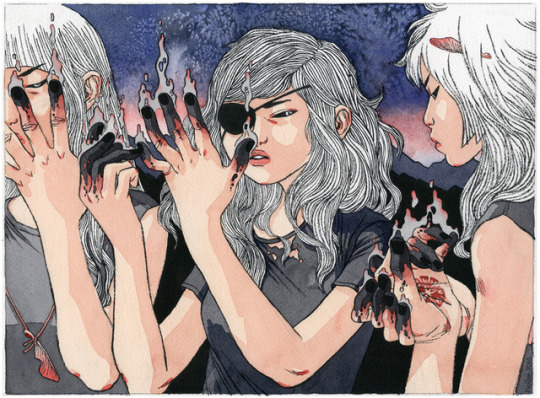

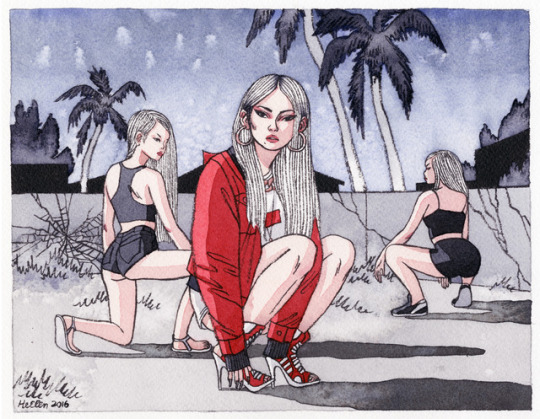
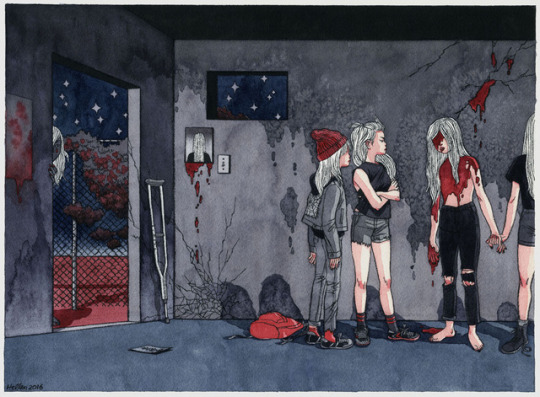
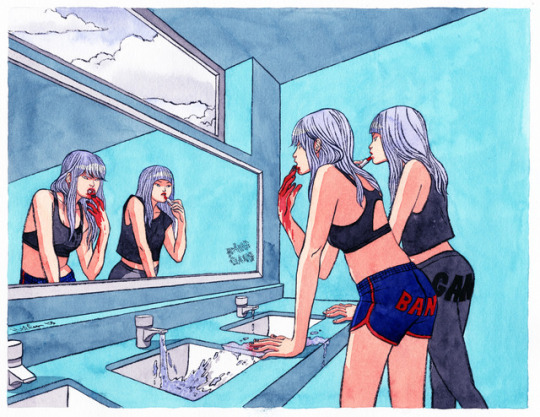
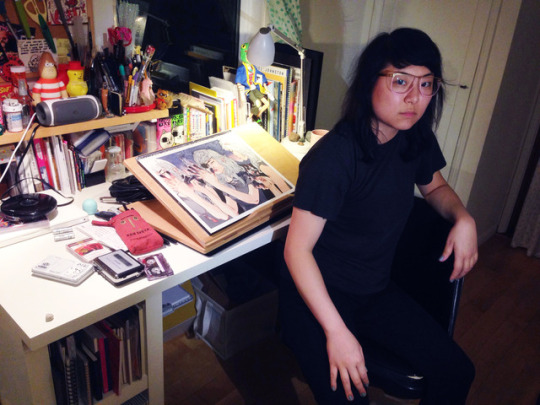
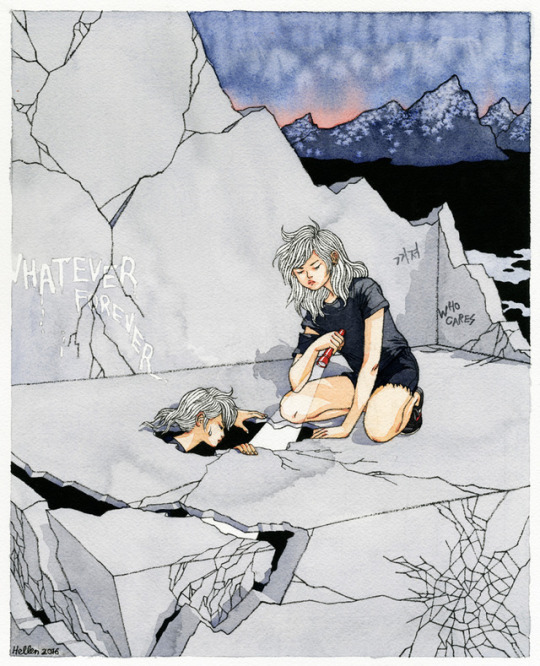
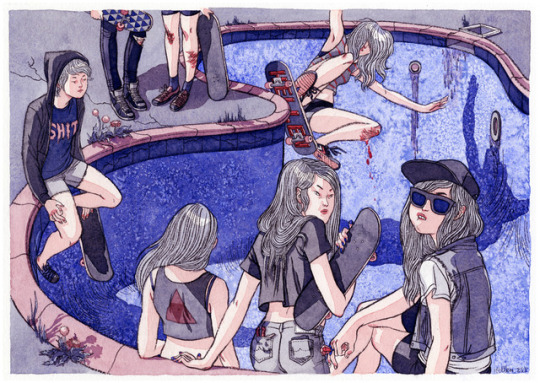
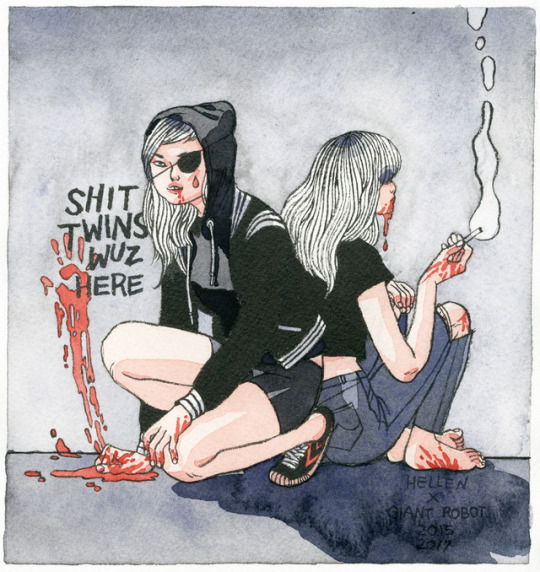
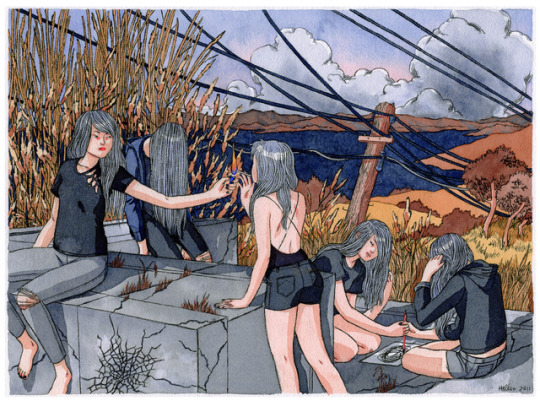
Sketchy Behavior | Hellen Jo
Never afraid to speak and/or draw her mind, Los Angeles based artist and illustrator, Hellen Jo and her characters can be described as rough, vulgar, tough, jaded, powerful, bratty and bad-ass - AKA her own brand of femininity. Known for her comic Jin & Jam, and her work as an illustrator and storyboard artist for shows such as Steven Universe and Regular Show, Hellen’s rebellious, and sometimes grotesque artwork and illustrations are redefining Asian American women and women of color in comics. In fact, that’s why Hellen Jo was a must-interviewee for our latest Sketchy Behavior where we talk to her about her love of comics and zines, her antiheroines, and redefining what Asian American women identity is or can be; and what her ultimate dream project realized would be.
Tell folks a little about yourself. So is it Helllen with three “l”’s? Mainly because your IG handle and website has a whole lot of extra “l”’s?
Haha my actual name is Hellen with two L’s. All my emails and urls contain a different number of L’s to confuse everyone. My grandfather took my American name from the Catholic saint, but he spelled it wrong, and now I share the same name as the mythological progenitor of the Greek people. But I like it better than my Korean name, which literally means, “graceful water lily” HAHAHA. I am an illustrator-slash-painter-slash-I-don’t-know-what living and working in Los Angeles.
Let’s talk about your early childhood / background. I read you’re from San Jose, CA and both your folks were professors, which is really cool!! How did you end up making art instead of teaching a room full of students about Hotel Management or Medieval History? Just curious where you got your “creative bug” and what early comics, arts, and/or influences led you down the road to becoming an artist?
I grew up in South San Jose, and yes, both of my parents are professors, of finance and of applied linguistics. A lot of my extended family are professors too, so I grew up parroting their desire for academia, but really, I started drawing when I was a wee babe, and I’ve always wanted to be a cartoonist. When I was really young, my parents drew for fun, really rarely; my dad could draw the shit out of fish and dogs, and my mom painted these really beautiful watercolor still lifes. I was fascinated, and I’d spend all my time drawing on stacks and stacks of dot matrix paper by myself. My parents also had a few art books around the house, and I remember staring so hard at a book of Modigliani nudes that my eyes burned holes through the pages.
What was the first comics you came across?
The first comics I ever got were translated mangas that were given to me by relatives when we’d visit Korea. I remember getting Candy Candy, a flowery glittery shojo manga for girls, and I was mesmerized by all the sparkly romance and starry huge eyes. I was also enthralled by Ranma ½, a gender bending teen manga that was equal parts cute art, cuss words, and shit too sexy for a kid my age. However, I was mostly thrilled that I could understand the stories with really minimal Korean reading skills, thus cementing a forever love of comics. In junior high and high school, I read a mix of newspaper strips and some limited manga, and I was enthralled with MTV cartoons “Daria” and “Aeon Flux”, but I wasn’t exposed to zines or graphic novels until I moved to Berkeley for college.
Did you have a first comic shop you haunted? What did you fill your comic art hunger with?
Being a super sheltered teen with not-great social skills, I was lonely my first semester, so I would lurk at Cody’s Books and Comic Relief every single day after classes. I read the entirety of Xaime Hernandez’s Love & Rockets volume, The Death of Speedy one afternoon at Cody’s, and it literally made me high; I was so hooked. I amassed some massive credit card debt buying and reading as many amazing comics as I could those first (and only) couple years of school: all of Los Bros Hernandez’s Love & Rockets, Dan Clowes’ Eightball, Julie Doucet’s Dirty Plotte comics, Peter Bagge’s Hate series, Chris Ware’s Jimmy Corrigan, Charles Burns’ Black Hole, Taiyo Matsumoto’s Black and White, Junji Ito’s Tomie and Uzumaki volumes… I could not believe the scope and breadth of the alternative comics genre, and the stories were so insanely good; they literally mesmerized me. I was so obsessed; I even skulked around the tiny comics section at UC Berkeley’s Moffitt Library in search of books I hadn’t read, and amid the fifty volumes of Doonesbury strips, some sick university librarian had included an early English translation of the Suehiro Maruo collection, Ultra Gash Inferno. That book blew my tiny mind about a hundred times; it’s totally fucked up erotic-grotesque horror porn, but the art is unbelievably beautiful. I read that entire thing sitting on the floor in the aisle, feverishly praying to God to forgive my sins after I finished the book, because I was way too ashamed to check it out of the library.
How about zines? I imagine a comic devouring ….
I devoured zines at a nearly equally fervent pace, including those by Aaron Cometbus, Al Burian (Burn Collector), Doris, John Pham, Jason Shiga, Lark Pien, Mimi Thi Nguyen, etc. I had never seen a zine before in my life, and suddenly, I was living in a town full of zinesters. I was drowning in inspiration. I tried to copy the art and writing of everything I read, and I spent a lot of my time making band flyers, trying to pass off zines as suitable replacements for term papers (this worked just once), and making monthly auto-bio comics for a few student publications. Eventually, I dropped out of school, then dropped out of school again, and I made my first published comic, Jin & Jam; then it all became real.
What was your early works like? and how did these become fodder for your self-published stuff later? What about your own experiences did you feel needed to be expressed in your own comics and artwork?
As a kid I was mostly copying sparkly girl manga and Sailor Moon stickers, and I don’t think I’ve really strayed all that far from that. My first few zines were cutesy autobiographical comics about crushes and falling asleep at the library; incredibly dull stuff. I made a super fun split comic/ep with this band I loved, The Clarendon Hills, but after that point, I was tired of drawing cute, goofy shit.
I had also really been obsessed with Korean ghost horror movies in high school, and I wanted to make comics that reflected more of that kind of coming-of-age violence and rage, so I made a couple standalone horror comics, Paralysis and Blister. These were longer than anything I’d ever done (forty to fifty pages each), and I felt like I was finally figuring out how to write interesting stories. I eventually dropped out of school and made Jin & Jam, based a bit on growing up in San Jose and on other kids I had grown up with.
At the time, there were still relatively few Asian American women in comics, and I was tired of whatever hyper-cute, yellow-fever, Japanified shit we were being pigeon-holed into, so I reacted by writing and drawing vulgar girls who started fights and didn’t give a fuck. I went to art school for a few semesters, got better at drawing people, and went on to draw nothing but mean bad girl ne'erdowells. I’d never been a very strong or defiant personality outwardly, but I’ve always been a pretty big fuckin bitch on the inside, and I just wanted to draw how I feel, in the most sincere way possible. And naturally, over the years, as I continued to develop this attitude in my art, I was able to express it better in person as well. Self-actualization through making comics!
For folks who don’t read comics, can you explain why they are SO AMAZING and moving to you! What about the format, art and overall genre makes them so great and not just your typical “funnies.”
I truly believe that comics are the greatest narrative format and art medium of all time! They are completely full of potential; you can draw and write whatever the hell you can think of, there are no real rules, and you as author and artist can create a deep and intimate experience for your reader. You can bare your vulnerabilities or yell at the world or create a visual masterpiece or inform people, visually and narratively. I don’t even believe that good art makes good comics; writing is king, and the art should really serve to further the story. Some of the worst comics I’ve ever seen had the most amazing art, and some of the greatest comics I’ve loved have the plainest, most naive, even ugly visuals, but those authors were able to finesse a symbiotic relationship between the text and the images to tell a compelling story. People are already so drawn to images, so it makes sense to me that they can enhance a reader’s literary experience so much.
I read that Taiyo Matsumoto is one of your all time inspirations. Most folks probably don’t know much about this master of comics, heck my knowledge is limited, so what makes his work speak to you so much? Perhaps it’ll encourage folks to venture into a new world of art exploration through visual comics.
Taiyo Matsumoto is the all time master of coming-of-age comics. I worship at his altar, for real. He is a Japanese artist, so technically his work is manga, but his masterful storytelling and singular visuals are so different from most manga, beyond categorization. He writes quiet, powerful stories about boys, girls, and teens who live in uncaring worlds surrounded by unfeeling adults, but they rise to these challenges and thrive in spite of themselves. The characters feel deeply, and the reader can’t help but ache and rage and celebrate just as fully. The drawings are beautiful and sensitive, with rough, loose artwork consisting of scratchy lines and cinematically composed shots.
What were some of your first memories with his work?
I remember buying the first two Pulp volumes of Black and White (also published as Tekkonkinkreet) at Comic Relief, reading them both at home that day, and then, covered in tears, literally *running* back that evening to buy the last volume before the store closed. I probably cried a dozen times while reading it; it’s a story about two orphan boys who protect each other in a neo-Vegas-like city of vice, but the characters were so brutal and brilliant and poignant. I had never read anything like that before, and it literally made me sick that, at the time, none of his other works were available in English. Eventually, I figured out that he was more widely published in Korea, so on every family trip, I’d run away from my folks for a day and buy as many of his books as I could carry back to the US. I made my way, slowly, through the Korean translations of Hana-otoko, Ping Pong (another incredible favorite!), and Zero. A beautiful collection of short stories, Blue Spring, was published in English, and then VIZ began translating the series No. 5, but they abruptly stopped mid-series due to low book sales. I was so starved for his work that at that point, I’d ebay his art books and comics only available in Japanese and just stare at them. Eventually, Black and White was made into the anime film, Tekkonkinkreet, and Ping Pong was made into an anime mini-series, and his rise in popularity ensured a wider English availability of his work. His current series, Sunny, is being translated and published here, and every volume breaks my heart a million times.
I’m sorry, this just turned into a gushy, gross fan fest, but Matsumoto’s books really changed my entire perspective on how comics can be written and paced, how characters can be developed fully, and how important comics really are to me. I love them so much!!!!!
You’ve worked in so many cool fields such as a storyboard artist and designer, and on various cartoons, such as Steven Universe. For folks who are interested in those fields, what can you tell folks about that? I’m sure like most artists, you’d rather be spending those long hours working on your own personal art, so how do you balance them? How did you move from a comic artist to working as a storyboarding artist?
I stopped working in animation about a year and a half ago, but the transition from indie comics to storyboarding was rough one, for me. I got into storyboarding at a time when a lot of kids’ animation networks were starting to hire outside the pool of animation school graduates and reach into the scummy ponds of comics. In my case, the creator of Regular Show, JG Quintel, had bought some of my comics at San Diego Comic-Con from my publisher, and he offered me a storyboard revisionist test.
Some cartoonists, like my partner Calvin Wong, were able to transition wonderfully; cartoonists and board artists are both visual storytellers, and once they’d learn the ropes, many of them thrived and succeeded. I can’t say the same for myself; I have major time management issues, I draw and write incredibly slowly, and going from working completely alone to pitching and revising stories with directors and showrunners was just a real shock to my system. For most of my time at Cartoon Network and FOX ADHD, I wasn’t able to do much personal work, but I crammed it in where I could.
Storyboarding also requires a lot of late nights and crazy work hours, to meet pitch deadlines and to rewrite and redraw large portions of your board. I just couldn’t deal. I lost a lot of weight, more of my hair fell out, and the extreme stress of the job put my undiagnosed diabetes into overdrive (stress makes your liver pump out sugar like crazy, look it up, people!) I realized that this industry was not meant for lard lads like me, and when the opportunity came to stop, I did. I could never figure out the balance between my job and my personal work, and I finally chose the latter. Now I’m trying to figure out the balance between making personal work and surviving, but I’ve yet to crack that nut either!
From your art I get a sense of rebellion and angst, how did this morph into an outlet through comics, cartoons, and illustration? Some aspects of your work that are so cool is the fact that your characters are female and women of color and in a completely new way. Asian characters definitely get stereotype in art and comics, so when did you consciously start to create these awesome antiheroines and redefine what Asian/Asian American women/girl identity is or can be?
A lot of the seething rage bubbling behind my eyes has been simmering there since childhood, and a very large portion of that anger comes directly from all the racism and sexism I’ve experienced as a child and adult. I’ve been treated patronizingly by boys and men who expect an Asian girl to be frail, demure, receptive, and soft-spoken. I’ve experienced yellow fever from dudes who are clearly more interested in my slanted eyes and sideways cunt than in whatever it is I have to say. Even in comics and illustration, people constantly tell me I must be influenced by Japanese woodblock print (pray tell, where in the holy fuck does that come from???), or they’ll look at a painting I’ve done of a girl bleeding from her mouth and dismiss my work as “cute”. I despise this complete lack of respect, for me and for Asian American women in general, and I’ve made it my life mission to depict my girls as I would prefer to be seen: fucking angry, violent, mean, dirty and gross, unapproachable, tough, jaded, ugly, powerful, and completely apathetic to you and your shit. Any rebellion and angst in my work comes directly from my own anger, and in my opinion, it makes that shit way better. Girls and women of color get so little respect in real life, so why not “be the change I want to see” in my drawings?
I think I was always aware of this lack of respect, and the “othering” of Asian American women, but once I got to college and learned to put a name to the racism and xenophobia and sexism and fetishism that we experience, my heart burst into angry flames, and it exploded into all of my art. I’ve never been able to hold that back, and I’m not interested in doing so, ever.
Talk about your process and mediums and process. Are you a night owl or an early bird artist? Do you have stacks of in-progress works or are you a one and down drawing person? Do you jot down notes or are you a sketch book person.
I am a paper and pencil artist all the way; I do work digitally sometimes, to make gifs or to storyboard, but I hate drawing and coloring on the computer. I’m terrible at it! I draw everything in pencil first, erasing a hundred thousand times along the way toward a good drawing. For my paintings, I’ll then ink with brush pen and paint with watercolor, all on coldpress Arches. For comics, I ink with whatever, brush pen or fountain pen, or leave the pencil, usually on bristol board. I’ve also been keeping sketchbooks more recently (never really maintained the habit before), where I like to doodle fountain pen and color with Copic markers. In sketchbooks, I’ll slap post-its on mistakes, a trick I learned from paper storyboarding on Regular Show.
I am a total night owl and a hermit; I have to be really isolated to get anything done, but at the same time, being so alone makes me crave social interaction in quick, fiery bursts. I’ll go on social rampages for a week at a time, and then jump back into my hidey hole and stay hidden for months, avoiding everyone. It’s not a very productive or healthy way to be, but it’s how I’ve always been.
I have great difficulty trying to juggle multiple tasks; I tend to devote all my mental energy and focus into whatever I’m working on at the time, so I need to complete each piece before I can do anything else. It’s an incredibly inefficient, time-wasting way of making art, but it’s also the only way I can produce drawings that I am satisfied with.
If we were to bust into your workspace or studio, what would we find? and what would you not want us to find?
You’d find an unshowered me, drawing in my underwear, which coincidentally is also what I do not want you to find!
You’d also find a room half made into workspace (more below), and half taken over by boxes of t-shirts and sweatshirts (I do all my own mailorder fulfillment, like an idiot!) I also like to surround myself with junk I find inspiring, so the walls are covered in prints and originals by some of my favorite artists, a bookshelf along the back wall is filled with about a third of my favorite comics and books and zines, and every available non-work surface (including desk, wall shelves, and bulletin boards) are covered in vintage toys, dice, tchotchkes, bottles, lighters and folding knives, weird dolls and figurines, a variety of fake cigarettes (I have a collection…)
Work-space wise, I have two long desks placed along a wall; the left desk has my computer and Cintiq, as well as my ancient laptop. Underneath and to the side of this desk are my large-format Epson scanner, fancy-ass Epson giclee printer, and a Brother double-sided laser printer. The right desk has a cutting mat, an adjustable drawing surface, and a hundred million pens and half my supplies/crafts hoard. I have a giant guillotine paper cutter for zines underneath this desk. I’ve got two closets filled with button making supplies, additional supplies/crafts hoard, and all kinds of watercolor paper, bristol paper, and mailing envelopes are crammed into every shelf, alcove, gap. This room has five lamps because I need my eyes to burn when I’m working. Also, everything is covered in stickers because I am obsessed with stickers.
What is something you’d like to see happen more often if at all in the contemporary art world? How’s the LA art scene holding up? Whaddya think?
As an artist who adores comics, I have a deep affection for low-brow mediums getting high-art and high-literary respect. Not that a comic needs to be shown in a gallery to be a valid art form, but I am so excited that comics that used to be considered fringe or underground are gaining traction as important works of art and literature. I wish this upward trajectory would continue forever, until everyone understands the love I feel for comics, but who knows what the future holds: the New York Times just recently stopped publishing their Graphic Novel Best Seller lists, and I think it’s a damn shame.
The LA art scene is really interesting to me, because it embraces both hi and lo brow work so readily; fancy pants galleries that make catalogues and sell to art dealers have openings right alongside pop-art stores that sell zines and comics, and I enjoy having access to both. I will say that I think LA galleries are a bit oversaturated with art shows devoted to television and pop culture fan art; yeah, I get that you loooooooove that crazy 70s cult classic sci-fi series and you want to draw Mulder and Scully and Boba Fett in sexual repose for the rest of your life, but I’m more excited about seeing new and original work from everyone. I know you have something to say, and I want to see it.
Mostly, I’d obviously love to see more women of color making art and making comics; we’ve come a long way since I started making zines in 2002, and there are some incredible WOC cartoonists making amazing work right now, but we need more more MORE!
What would be your ultimate dream project? What is something you haven’t tried and would love to give it a go at? Dream collaborations?
My ultimate dream project is the Great American Graphic Novel, but I am so shit at finishing anything that I have not been able to even approach this terrifying prospect. But I figure I have until the day of my death to make something, so … one step at a time?
As far as something I’ve never tried, I’ve been recently interested in site-specific installation; I’ve always been a drawer for print, confined to the desk, and I’m in awe of cartoonists and illustrators who have transitioned to other forms of visual media, whether it be video, sculpture, performance, whatever. I know my personality tends toward repeating the same motions forever and ever, and I hope I can break out of that and make something really different and challenging for myself. I also secretly want to make music but I am the shittiest guitarist ever so maybe it’s better for the world that I don’t!
The dreamiest collaboration I can think of is to illustrate a skate deck for any sick-ass teen girl or woman skater. Seriously, if any board companies wanna make this happen, EMAIL ME
Give us your top 5 of your current favorite comic artists as well as your top 5 artists in general.
Top 5 Current Favorite Comic Artists:
1. Jonny Negron 2. Jillian Tamaki 3. Michael DeForge 4. Ines Estrada 5. Anna Haifisch
Top 5 Artists of All Time
1. Taiyo Matsumoto 2. Xaime Hernandez 3. David Shrigley 4. Julie Doucet 5. Daniel Clowes
What are your favorite style of VANS? And how would you describe your own personal style?
My favorite VANS are the all-black Authentic Lo Pros, although I have a soft spot for my first pair of Cara Beth Burnsides in high school (they were so ugly and I never skated, but I loved them).
My personal style can be described as aging colorblind tomboy who dresses herself in the dark; my favorite outfit is a black hoodie with black denim shorts and black socks and black sneakers.
What do you have planned for this 2017? New shows? New published works?
I’ve got two group shows with some of my favorite artists in the works; I’m so excited but I can’t share any details yet. I’ve also been writing a new comic, but don’t believe it til ya see it!
Best bit of advice and worse advice in regards to art?
Best Advice: Never be satisfied; always challenge yourself to make your art better than everything you’ve done previously.
Worst Advice: Make comics as a stepping stone towards getting a job in animation. When people do this, you can smell the stink of insincerity a mile away. Fuck you, comics are a beautiful medium, and every shitty asshole who does this, I hate your guts!
Follow Hellen Jo
Website: http://helllllen.org Shop: http://helllllen.bigcartel.com Instagram: @helllllenjjjjjo
Images courtesy of the artist
2K notes
·
View notes
Text
Japanese Nats: The Aftermath
This recap is almost 3 weeks late but fwiw I judged the event on The Judges’ Table. If you’re interested in my (serious) opinions about the competition, you can read them there. If you’re interested in my less censored opinions, I will include as much as I can in this post.
So what happened is that Japan crowned their tiniest champions ever, Satoko Miyahara (her 3rd title) and Shoma Uno (his 1st title). But some people were less interested in that and more interested in receiving updates on Yuzuru Hanyu’s recovery after he decided to withdraw from the competition in order to prioritize his health, thus generating earthquakes among his sensitive fans. Other people (those who attended the competition) went just to see Mao Asada but they were polite enough not to get up and empty the arena while Mao wasn’t skating unlike what happened at the Sochi Olympics when Evgeni Plushenko withdrew from the men’s event.
Now I’m not pretending to be some advocate of justice and I’m not intending to preach. But I believe this is a good opportunity to highlight frequent problems in the skating fandom so you won’t be tempted to fall into their traps.
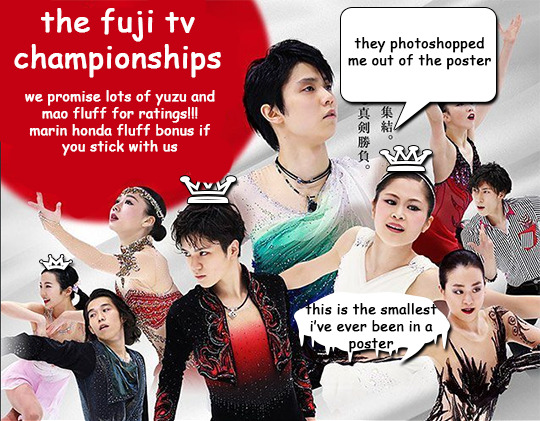
DISCLAIMER: I do realize I’m already in a very high risk of getting attacked by some Yuzu fans via anon asks or salty replies/reblogs but I’m gonna say this again: it’s okay if you’re not into my kind of “”””humor”””. You can ignore me and I promise I won’t get a boo-boo. GETTING TO THE SUBJECT NOW!
THE LADIES EVENT aka Game Of Thrones
Satoko Miyahara waltzed into this event giving negative fucks and the results showed: when she gives negative fucks, that 3Lz-3T combo in the second half of her SP is miraculously rotated. As a consequence she got 76 for her program and further established her new position as one of the most overscored skaters currently competing (don’t believe me? Ask the Russian ubers and Mao ubers). I also thought “damn, this empty program actually looks nice when neither she nor I have to worry about rotations”. But the key here is to make the program look like that when you give a lot of fucks as opposed to negative fucks, and Mie Hamada knew that. So the next day before Satoko skated her FS, Hamada annoyed the crap out of her and pressured her as a strategy to make her get used to skating clean when she gives a lot of fucks, such as when she’s thinking she’s gotta get a medal in a relevant event, including the Olympics. For now, Satoko is still failing that test because she had a step-out on the 3Lz-3T combo and a couple of carrots.
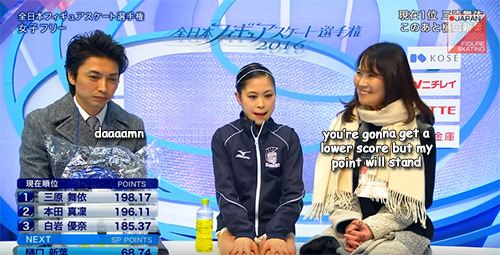
Wakaba Higuchi finally - I repeat - FINALLY skated a clean short program and it was so adorable to see her get all excited and happy about it. Except it wasn’t a squeaky-clean program because she got a wrong edge call on her flip. What can ya do, if ya got a good lutz ya gotta lip and when ya got a good flip ya gotta flutz. She’s gonna have to follow Satoko’s example and replace that lip with a loop and be done with it. Other than that, damn this girl got huge jumps. Everyone loves some huge jumps. However, the disadvantage of huge jumps is that you gotta have very good control of the landing and you have to know how to manage your speed, when to speed up, when to slow down, otherwise you’re doomed to pull a Midori Ito and land your jumps over the cameraman outside the boards. (Have you imagined Evgenia Medvedeva landing one of her 3-3-3 combos on Tarasova’s table cause I did and I cracked myself up really).

Another skater who is fast as crap and has great technique on top of that is Mai Mihara who won the bronze medal and got herself a ticket to Worlds. Just a year ago around this time she was watching Nationals on TV from a hospital bed having been diagnosed with juvenile rheumatoid arthritis. Doesn’t that make a great Cinderella story? She is, actually, skating to Cinderella but her style is still stuck somewhere on the road between junior and senior (she was pretty good as a junior but I didn’t like her skating then and I’m not necessarily warming up now) but she seems like a very sweet girl and if there’s anyone who deserved going to Worlds aside from Satoko and Wakaba, it’s this young lady.
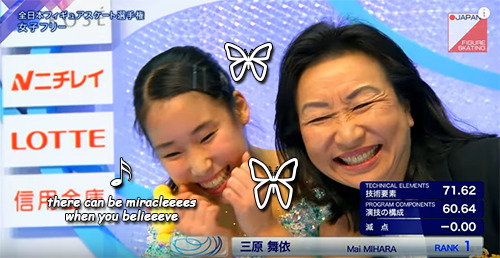
Marin Honda is another skater who finally - I repeat - FINALLY skated a clean short program after burying herself in competitions right from the start. The poor girl has been under so much constant pressure this season I feel like she’s always on the verge of having an emotional breakdown. It’s not only the fact that she’s cried a number of times after her performances, but this season she always looked like she was terrified of her results no matter how she skated. I’m not a fan of either of her programs this season (SP is similar to last season’s and the FS is a hot mess combo of Yuzuru’s Romeo & Juliet 1 and 2) but she has excellent skating skills, musicality, expression, projection to the audience for her age. She doesn’t have the best jump technique but she is one of the few lucky ones with a clean lutz AND flip. After a smooth short program, a popped jump in the free prevented her from stepping onto the podium but that’s how it is in competition; it’s not about what you’re able to do, it’s about what you end up doing when it counts.

Rika Hongo has been in serious trouble ever since the beginning of this season - or maybe as far as the previous Nationals - and the worst case scenario happened. She finished 5th and now the juniors ahead of her are old enough to go to Worlds in her place. While she was 2nd in the SP with the best performance of the season, she went down to 6th in the FS and finished 5th overall despite bringing back Riverdance, a program that worked for her last year. Unfortunately the spark, the freedom and the joy that was present last season was absent in this competition as she was very nervous even before she took the ice.
Yuna Shiraiwa on the other hand... I’m only going to say this. Clean 3Lz-3T and (second half) 3F-3T combos in the FS. No UR calls. Highest TES (71.74) of the evening. She’s the real MVP in Hamada’s team.
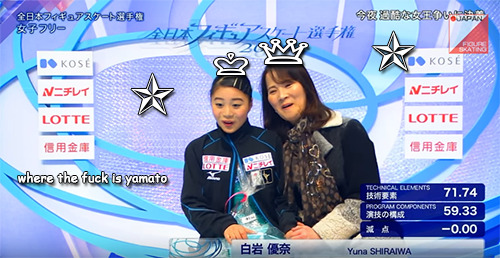
THE OLD(ER) GENERATION

This was Mao Asada’s worst result at Nationals but instead of having retirement thoughts (like she had last season at Nationals even though she skated better), she’s still determined to come back stronger next season. An old knee injury prevented her from landing the 3A and rotating a lot of her jumps but at this point she’s obviously not skating for the medals as much as she’s skating for herself. No skater wants to leave the competitive world with regrets so who are we to judge Mao’s decision to continue in spite of physical difficulties? With Yuzuru absent due to influenza, most fans attended the competition to see Mao and it was obvious just counting the number of flowers that were thrown on the ice for her compared to the other skaters.
Redemption from Kanako Murakami, who is also nearing the end of her career but managed to deliver the first clean FS she’s skated in ages. That’s all she wanted from this competition, she got it, and she awarded the audience with her signature Kanako Smile.
Painful competition for Haruka Imai, former Japanese Jr National Champion and 4th at the 2014 4CC. No GP assignments this season, she was plagued by inflammation of her hips and knees but she fought to land the 3Lz and 3F. This was also the first time we got to see one of her new programs (the FS, which is Primavera by Einaudi) and she’s still beautiful to watch.
SHOMA UNO & CO.
It was kind of depressing to watch the men’s event this year because only a couple of years ago it was the fiercest event at Nationals. Keiji Tanaka seized his chance to grab onto the silver medal while Takahito Mura’s bronze was (once again) useless - as harsh as it sounds. Shoma wasn’t at his best here but he showed that he learned a new lesson (tag a 3T to a different jump if you screw up one of your planned combos!!) and he came out of this alive and well. The added pressure of having to “live up to expectations” in the absence of Olympic King Zuzu was another thing he suddenly had to put up with (good job Fuji). But there’s an old saying; “better here than at Worlds”.


CONTROVERSIES
While Satoko and Shoma are the tiniest champions Japan has ever had, they’re also the most criticized. They both have to skate under the shadows of two skating giants, Mao and Yuzuru, who have hoards of fans. Among those hoards of fans there are ubers, people who have made a habit out of bashing their favorite skaters’ successors. In Japan there already are Mao ubers whose jobs are to tear Satoko apart and the disease has long spread worldwide. You can see it on forums, you can see it on comment sections of YouTube videos, you can even hear it on television (looking at you Simon Reed). People who write passive-aggressive, sarcastic remarks, calling Satoko names and whatnot. Shoma gets similar (though mellower) treatment from overseas fans, but not from Japanese fans, possibly due to the fact that he’s a Daisuke Takahashi fan so most of Dai’s fans are now supporting him.
These two young skaters (and not only) deserve all the support in the world. It’s not easy to become Japan’s supporting pillar and leading lady after the great Mao Asada, but Satoko is doing an incredible job. Appreciate more, bash less. Don’t let the judges cloud your judgement. There’s also a massive amount of PR in figure skating; Mao has so many sponsors you can see her in commercials, you can see fluff videos about her because that’s what the general audience wants. She’s been advertised as a child prodigy (which she was) and people consider her part of their family. Satoko doesn’t benefit from that kind of treatment so people tend to be cold and judgmental towards her because she’s nothing compared to Mao-chan (oh dear those jumps, oh dear the way she bends her knee, oh dear her face).
Recently Marin Honda has been getting the “heir of Mao” treatment, getting sponsorship from JAL, shooting CMs for Ghana and stuff. I feel like I have to point out the fact that all of her siblings, including herself, are managed by a hugely influential management company. If you’re into Japanese entertainment, you might have heard of it. It’s called Oscar Promotion and it’s a talent agency whose famous names include actresses Emi Takei, Aya Ueto and Ayame Gouriki. She’s been promoted and modeled by a talent agency since she was a young child so she’s an expert at working with the camera, the audience and the reporters. As a result she’s also been gathering - well, pretty scary fans who are downright infatuated with her and will start arguments if you dare criticize her. Similar to idol group fans, I’d say.
But this is figure skating and crack commentaries aside we’re talking about real, young people with feelings who are training every day from dawn till dusk, who get injured, who sacrifice their childhood and adolescence. We’re also talking about real fans behind the computer screen who like who they like and no one person is entitled to criticize or ridicule the things that make them happy. At the same time, no one is entitled to attack fans who criticize your favorite skater(s) as long as they bring valid arguments and they’re polite about it. And no one is entitled to attack another fan whose way of seeing or perceiving things is either more or less intense than yours. Be nice to each other. #PEACE
156 notes
·
View notes
Text
Hiroshima Timeline project under fire for racism, fabricated history
New Post has been published on http://khalilhumam.com/hiroshima-timeline-project-under-fire-for-racism-fabricated-history/
Hiroshima Timeline project under fire for racism, fabricated history
“Those damn Koreans (朝鮮人の奴ら) are openly taunting us, saying “The war's going to be over soon” and “Japan's going to lose, you know.” Excerpt from Hiroshima Timeline tweet on June 16, 2020. Screenshot of Tweet has been cropped, with full tweet embedded below. Image widely shared on social media.
An innovative NHK project about the August 6, 1945 bombing of Hiroshima has come under scrutiny for using racist epithets to describe Koreans, political interference, and for potentially fabricating historical source material. NHK's Hiroshima Timeline project, dubbed, “What If They Had Social Media In 1945” (もし、75年前にSNSがあったら) features tweets based on the diary entries of three people who lived through the bombing of Hiroshima in August, 1945. Regular people in Hiroshima, including high school students, have helped write the daily tweets and hundreds of thousands of people have followed along and engaged with the project on Twitter. Daily tweets about life in Hiroshima in 1945 are planned until the end of 2020. In August, however, observers in Japan and around the world noticed the NHK-sponsored project was using a racial slur to describe ethnic Koreans who would have lived in Hiroshima in 1945.
So the NHK, Japan's largest TV station, set up an official account commemorating the 75th anniversary of Hiroshima bombing, and their idea of commemoration is using a racial slur against Koreans who are supposedly terrible people for rooting for Imperial Japan to lose WWII.
— T.K. of AAK! (@AskAKorean) August 21, 2020
The slur, chosenjin (朝鮮人), is used by the persona of Shun (hereafter referred to as @nhk_1945shun), a 12-year-old boy and one of three characters whose diary entries are shared in NHK's Hiroshima Timeline project.
【1945年6月16日】 朝鮮人の奴らは「この戦争はすぐに終わるヨ」「日本は負けるヨ」と平気で言い放つ。 思わずかっとなり、怒りに任せて言い返そうとしたが、多勢に無勢。 しかも相手が朝鮮人では返す言葉が見つからない。奥歯を噛みしめた。#ひろしまタイムライン#もし75年前にSNSがあったら — シュン@ひろしまタイムライン (@nhk_1945shun) June 16, 2020
June 16, 1945 Those damn Koreans (朝鮮人の奴ら) are openly taunting us, saying “The war's going to be over soon” and “Japan's going to lose, you know.” Although I felt myself giving in to my anger and was going to taunt them back, I finally just felt overwhelmed. Anyway, I couldn't even find a suitable retort for the Koreans, so I just bit my tongue.
About 2 million Koreans resided in Japan in 1945. Some had settled in or had been brought to the country after Japan colonized Korea in 1910, while between 1939 and 1945 up to 800,000 Koreans were conscripted during the war to work in Japan's wartime industries. In 1945, an estimated 80,000 ethnic Koreans lived in Hiroshima, at least 30,000 of whom would die immediately in the atomic attack. About one million ethnic Koreans still reside in Japan, and still experience discrimination. According to Twitter user “Tomoka Phenomenon” (ともかフェノメノン, referred to hereafter as Tomoka) NHK's Hiroshima Timeline project appears to have published at least four different tweets that included the term chosenjin (朝鮮人), including the following:
【1945年8月20日】 朝鮮人だ!! 大阪駅で戦勝国となった朝鮮人の群衆が、列車に乗り込んでくる!#ひろしまタイムライン#もし75年前にSNSがあったら — シュン@ひろしまタイムライン (@nhk_1945shun) August 19, 2020
August 20, 1945 The Koreans are coming! A horde of Koreans, acting as if they have just won the war, are on their way (to Hiroshima) by train from Osaka!
Since the tweets sent by the three Hiroshima Timeline Twitter accounts are supposed to be based on actual diary entries by three real people in Hiroshima in 1945, Tomoka searched through Shun's original diaries to find some context for the tweets about Koreans.
#ひろしまタイムライン のシュンが「朝鮮人」という語句をどれだけ使っているのかと思って検索すると6月16日に「朝鮮人」を含むツイートが3件見つかった。 この日何があったんだろう?と日記の原文を辿ると、そこには「朝鮮人」なる語句も、蛇を食べたという話も、まったく書かれていなかった。 pic.twitter.com/5ujEhUUx47 — ともかフェノメノン (@tomoka_hidden) August 20, 2020
I started to wonder just how much Shun from #Hiroshima Timeline had actually used chosenjin in his diary. First, I searched the @nhk_1945 on June 16 (1945) for tweets that included chosenjin. I found three. Following up, I took a look at that day in 1945 to find out what happened Shun (to make him disparage Koreans). However, there was no mention of Koreans in his diary […]
The Mainichi Shimbun also reported that Shunichiro Arai, the real person upon whom the @nhk_1945shun's tweets are based, never made disparaging or racist remarks about Koreans in his diaries:
Diary entries by Shunichiro Arai, whose writing forms the basis for Shun's tweets, are being published on the Hiroshima Timeline official website, but there is no mention of “Korean people” in the original text. As a result, one user has commented on Twitter, “I'm not sure to what point this is historical fact, or to what point it is imagined; there also aren't explanatory notes.”
Besides the dubious decision to use the epithet chosenjin in the Hiroshima Timeline project, Twitter user @wayto1945, who publishes a blog that takes a comprehensive look at Japan's colonization of the Korean peninsula, said that the Hiroshima Timeline tweets about supposed ethnic Korean impunity in the dying days of the war are historically incorrect. Instead, even following the end of the war, ethnic Koreans in Hiroshima still regularly experienced violence. A tweet published on August 21, 2020 by the @nhk_1945shun account includes potentially fabricated content that misrepresents the dangers ethnic Koreans in postwar Japan actually faced:
誰も抵抗できないどころか、1946年8月までの1年間で37件の朝鮮人虐殺、警察扇動による暴力団との衝突、炭鉱争議への警察介入等があったし、敗戦直後は関東大震災時の朝鮮人虐殺が再発する事への恐怖心があったと朝連(当時の在日朝鮮人団体)によって記録されている。https://t.co/JAZBW632Q4 — 1945年への道 (@wayto1945) August 22, 2020
Quoted tweet by @nhk_1945shun: [August 20, 1945] I did not have the will to stop crying. At one moment, our own defeated veterans push their fellow Japanese civilian countrymen off the train (to make room). In the next moment, the Korean “victors” pull Japanese passengers off the train with impunity, and no one can resist. How wretched. @wayto1945's response: Far from there being no resistance, there were 37 incidents of Korean massacres over the course of the year following the end of the war until August 1946, as police clashed with organized gangs and intervened in coal mine disputes, etc. According to the records of the Choren (one of the main ethnic Korean associations in Japan at that time), it was feared that, following the defeat, Japan would see another massacre of Koreans like what happened after the 1923 Great Kanto earthquake (when at least 6,000 ethnic Koreans were killed in mob violence).
In response to growing online criticisms, the official NHK blog for Hiroshima Timeline explained that the tweets made by the three Twitter accounts are actually composites, and were based on interviews and diary entries made by multiple people who experienced the end of the war, a fact not originally made clear on the Hiroshima Timeline website. NHK explained that @nhk_1945shun's tweets, while not always based on diary entries made by the real Shun, who did exist in 1945, are instead intended to represent how many boys his age must have felt at the end of the war, to answer the question, ‘What kind of things might this person have posted on social media?’
当時中学1年生だった男性にとって、道中の壮絶な経験が敗戦を実感する大きな契機になったことに加えて、若い世代の方々にも当時の混乱した状況を実感をもって受け止めてもらいたいと、手記とご本人がインタビューで使用していた実際の表現にならって掲載しました。
In order to illustrate the saga of a junior high school experiencing the defeat in war, and to help younger generations understand the confusion of that time, (the Hiroshima Timeline creators) included actual expressions used by people we interviewed for the project.
The answer, NHK seems to indicate, is that people would have posted hateful comments about Koreans if social media had existed in 1945. Back on Twitter, Tomoko also questioned how much oversight there was over Hiroshima community participants who crafted some of the tweets, none of whom are trained historians, all collaborated to create @nhk_1945shun's tweets. If the diaries didn't include any mention of Koreans, who directed the team to include the racist term? Using screenshots, Tomoka also notes that “Yamaneko”, a pseudonym of one of the Hiroshima citizens who helped craft Shun's tweets, says they “received advice from” a public servant (公務員) identified as Ito Naoto, an employee of the Ministry of Economy, Trade, and Industry (METI). Ito, in turn, on a social media post screenshotted by Tomoka, states he received “valuable advice” (貴重なご意見) from a Hiroshima municipal assembly member Toyoshima Ganpaku. Tomoka asks:
公共放送の番組に関わる人に、地元政治家はどのような意見を述べたのだろうか?
What sort of opinions did a local politician give to people connected to a public broadcaster?
Toyoshima Ganpaku made the national news earlier in July for receiving cash payments from disgraced former Japanese Justice Minister Kawai Katsuyaki, who was arrested after a vote-buying scandal in Hiroshima prefecture. Twitter user Tomoka, who spent considerable effort unraveling who might be responsible for the racist content, also notes that, according to the Hiroshima Timeline project page, the primary technical experts guiding the creation of the tweets were two playwrights, rather than historians, and their primary motivation may have been to create drama, rather than historical accuracy.
サポートや監修の方々がすべて悪いと言いたいわけではない。 彼らは「演劇」という、彼らの職能に求められた仕事をしたわけだから。演出家や役者の方に史学者の能力を求めるなんて、八百屋に行って魚を探すようなものだ。 問題があるのは、八百屋に魚のさばき方講座を求める @nhk_hiroshima だ。 — ともかフェノメノン (@tomoka_hidden) August 20, 2020
I'm not trying to say the project supervisor and the other people who worked to make it are bad. There job was to create a “narrative”, which is what they're paid to do. However, asking a director or an actor to play the role of an actual historian is like going to a greengrocer to buy a fish. The real problem is @nhk_hiroshima (which was involved in commissioning and managing the project) asked a greengrocer to lecture us on “what makes a good fish” in the first place.
< p class='gv-rss-footer'>Written by Nevin Thompson
0 notes
Text
The Social Theory: Its Uses and Pleasures by Charles Lemert ( Understanding)
Sa nakaraan nating lesson na about sa “Socioogical Imagination” ni Wright Mills, sinasabi na we have to possess a quality of mind which is the Sociological Imagination to understand the connection between society and ourselves. From that quality of mind we can now create a social theory. So now let us interpret the Social Theory:Its Uses and Pleasures” by Charles Lemert. Ang Social Theory ay matagal ng nageexist sa ating mundo ngunit ito ay napagtuunan lamang ng pansin noong eighteenth century. Ano nga ba ang Social Theory? Ito ay mga ideya, argumento, opinyon o spekulasyon patungkol sa kung paano at bakit nabubuo at nagbabago ang society natin. Sinabi din ni charles Lemert na ang Social Theory ay “Basic survival skill” Bakit? sapagkat ito ay makatutulong upang mabuhay o makasurvive tayo sa society na ating kinabibilangan. Sinabi ni Lemert na anyone can be a social theorist, nagbigay siya ng halimbawa na patungkol sa kaniyang anak at kay Lafeyette. Sinabi dito na noong elementarya daw ang kaniyang anak, naobserbahan nito na sa tuwing pupunta sa canteen, lagi silang pinapapila ng tahimik at hiwalay sa pila ng babae. Kinagabihan sinabi niya ito sa kaniyang ama, “Para sa ito?” “Sa tingin ba nila ay aatakihin namin ang mga babae?” Ngunit ng sya ay mag junior high school doon niya napagtanto ang dahilan nito. He used his own words bbut he developed a social theory kaugnay sa naging katanungan niya. Samantala sa “There is no children here” ni Alex Kotlowitz, Inemphasize dito yung sinabi ni Lafeyette na “If i grow up, i want to be a bus driver” instead of saying na “when i grow up” ( na kadalasan yun naman ang sinasabi natin sa panahon ngayon) dahil he is aware of what situation they have , alam niya kung ano ang kinahihinatnan ng mga tao o kabataan sa kanilang lugar. What it implies here is that anyone can be a social theorists, whatever social class, age, gender and race you are in, you can create a social theory. Saan ba nagsisimula ang social theory? it starts from our curiosity, experience and situation in life or kapag hindi muna kayang tanggapin ang ginagawa ng society sayo. Social Theory is everywhere but the problem is nasa atin, ano nga ba ang rason kung bakit hindi natin ito masabi or mai-put into words. 1) Wala tayo sa posisyon, wala tayong kapangyarihan o kakayahan kung kaya’t tinatanggap na lamang natin ang nangyayari. 2) Meron namang iba na nakikita na nila but they were trying to deny and ignore it dahil alam nilang wala rin silang magagawa dito. 3) Some need time and experience para masabi nila kung ano ba talaga ang nangyayari, they takes time to realize. Ngunit hindi ba’t sinabi ni lemert na anyone can be a social theorist, pero bakit may mga ganyan pa ding rason? Bakit may mga hadlang pa din, na mapasa hanggang ngayon ganito pa din ang nangyayari. Everyone can do it , Everyone can do more of it and from that we can become flexible and has an edge from others. This makes us more open and mas maintindihan pa ang mundo. Social Theory will help us to survive in this cruel world and this will lead us to pleasure, what pleasure it is? when we overcome the limitations and injuries that we’ve encounter, that survival is the prerequisite of pleasure. The world is unevenly cruel, whatever pleasures it offers, we offered only to those who find a way to get by in it.
0 notes
Text
Intertwined

written by Andrea Villa
It has been over a month since my last JEEP Saturday at Shopwise. It has still been one of the more memorable experiences of the semester, with me not expecting to have to do this until my junior year. But grocery, four Saturdays, four hours, blockmates? It couldn’t have been that difficult. I mean, I go to the grocery all the time, right? Apparently, wrong. I wasn’t informed on how much out off my comfort zone I would be thrown out off, and this experience definitely caught me off guard. From angry customers, to leaking eco bags, to boxes and boxes of ensaymada; JEEP was a different ride every Saturday. Yet, it was one I was grateful for. It was one that enriches the self.
Alejo has a unique concept of self. He talks about how one must not only look at the self from the outside looking in, but from your own inside towards the outside world. He also says that the self is a world of relationships. Alejo uses the analogy of islands; how from the surface, they may look distant and separate, yet once you delve in, these islands are interconnected on a much deeper level. They overlap much like how our own stories intertwine with those around us. These people have their own worlds, as well. It may be our family, friends, education, and even different institutions. These are mediated through our words, or anything that we may do in our everyday lives. This then makes the worlds meaningful.
Alejo adds on that that the self and the body are one: “ang pagbuo ng loob ay isang pangangatawan” (1990). The physical self carries along with it possibilities, dama, and kaya, which are all necessary requirements of the self. To change one of these affects all the other world that a self is connected to. (Note: Please excuse my sporadic use of Filipino words throughout the journal entry. Taglish, if you may. There are simply some words that carry with it more depth in the native language that cannot be directly translated into English, having to take into account its cultural context.)
There are several other requirements of the self as discussed in class, with the first two being pakiki-ugnay and pakikisangkot, defined in class as “relationships” and “engagement”. Throughout my visits, I was able to talk to a variety of people in the different stations I was placed. On the first Saturday, my blockmate Tiffany and I were in the meat section. We watched in amazement as the employees would punch in series of numbers with ease, while we struggled to go through their list of inventory to look for the code. We learned from them that it took several years to learn it like the back of their hand. Some of them even looked young, meaning they had to start working at a young age, probably to sustain their family.
On a different weekend, Tiffany and I were at the bakery, where we tried to talk to the Ate stationed there, though she was a quiet one. Yet, we were still able to learn about how the bakery works, how leche flan is made, and how long the shelf life is of the ensaymadas we made (five days!). It is through these little engagements and small talks that we were able to slowly intertwine our worlds with the employees’ throughout our short stay at Shopwise.
Abot-dama would be another requirement of the self, defined as “experience”. But to experience, given our cultural context, is much deeper than to do just that, because we can never truly grasp the experiences of others. To quote Alejo, “hindi ko sakop ang mga damdamin ng iba – abot ko lang, hindi ko sakop. Katunayan, kahit anong gawin kong pakikiisang-loob sa iba, hinding hindi ko ito maaangkin. Abot ko lamang; may pagkalapit ang aking pagdama at pagmalay” (1990). During our shift at the package counter, Tiffany and I learned that Shopwise does not accept employees that reach a certain mid-30s age. The reason as to why, we do not know, but the lady who told us this said it with the slightest bit of disappointment. We cannot fully experience this woman’s own experience, yet we can attempt to understand her, and this dimension of empathy is important to the self. It further adds to the complexity of our interconnectedness, and thus gives it more meaning.
One more value is that of abot-tagal, or “resilience”. From the first to the last Saturday, we could see the resilience and strength of the employees at Shopwise. We ourselves were having a hard time waking up early on a Saturday morning when we could easily sleep in, so we could only imagine what these Shopwise employees have to go through to make a living. To add to their job, they were kind and patient enough to teach us the ropes of each station of the grocery. I truly had newfound respect for these blue-collar workers who would go beyond for us students that they did not know. Hindi lamang nila inaabot hanggang dulo, subalit ginagawa nila ang mas higit pa rito.
I would like to end with one more quote from Alejo. He says, “maihahalintulad ko ito sa pagkalula mula sa pag-ahon sa bapor. Wala na ang bapor at ang maalong dagat, subalit hanggang ngayon ay tila idinuduyan pa rin ako ng aking mga nasaksihan at napagdaanan” (1990). It may have been over a month since my last JEEP Saturday, but I am constantly being rocked by my experiences from these three weekends. These are now a part of who I am; part of my ever-expanding connections of worlds and stories intertwined. It has given me a broader perspective on a community that I have overlooked yet has been close to me since I was young. It has shaped me, and will continue to shape me as long as I keep these memories alive. As pointed out by Kahneman in Life as a Story, our memories help in designing our future stories. Perhaps some time in the future I will be able to find solutions for these people’s problems, but for now there is only abot. May we all learn to understand, connect, and grow from this experience.
0 notes